
So you’re all set to take the world by storm with your new project, keen on dotting the i’s, crossing the t’s and getting market-ready. But wait – every new team needs some solid backing, and we’re not talking finances here. We’re talking essential startup tools that will help you shine brighter than all the competition.
With so many softwares, apps, and platforms hogging the cyberwaves, where do you draw the line? Welcome to our tried, tested, and scored list of must-have startup tools to streamline your team’s workflow and maximize productivity in any sector.
We’ll start out by highlighting some of the top startup tools for specific categories, before moving on to dissect which ones serve you well, and which fall short in some aspects.
Essential Tools for Startups by Category
| Category | Best Startup Tools |
| Project Management | Teamplate, Asana, Monday.com |
| Collaboration and Communication | Slack, Loom, Teamplate |
| Automation and Workflow Optimization | Teamplate, Trello, Slack |
| Time Management and Productivity | Teamplate, Notion, Hubspot |
| Team and Resource Management | Hubspot, Teamplate, ClickUp |
| File Storage and Document Management | Teamplate, Google Drive, Dropbox |
| Scaling and Growth Tools | Teamplate, HubSpot, Asana |
| Performance Monitoring and Alerts | Hubspot, Teamplate, Asana |
| User Access and Role Management | Teamplate, Hubspot, Asana |
| Mobile Accessibility | Notion, Grammarly, Teamplate |
Table of Contents
Benefits of Startup Tools
What do the right startup tools add to your team’s workflow, productivity, and motivation? A lot, it turns out. Here’s why making an informed choice is important:
✅ Increased Efficiency: Automate repetitive tasks, freeing up time for creative and strategic activities.
✅ Cost Savings: Affordable pricing and scalable plans that help startups keep costs low while accessing powerful features. Some startup tools like Teamplate are even 100% free.
✅ Better Collaboration: Streamline team communication to improve collaboration across remote or hybrid teams.
✅ Scalability: Choose startup tools that grow with the startup, accommodating new team members, customers, and operational demands.
✅ Data-Driven Decision Making: Gain access to analytics and insights that help you make informed decisions.
✅ Enhanced Productivity: Time tracking, to-do lists, and other productivity features help your team stay on schedule and hit deadlines.
✅ Resource Optimization: Distribute workloads efficiently, reducing bottlenecks and preventing burnout.
✅ Centralized Information: Store files, documents, and important information in one place for easy access and retrieval by the team.
✅ Rapid Onboarding: The best startup tools offer intuitive user interfaces and support resources that help new employees get up to speed quickly.
✅ Better Security: Secure data storage, compliance management, and role-based access help startups protect sensitive information.
✅ Flexibility: Use customization to suit your specific needs.
✅ Remote Work Support: Cloud-based startup tools enable remote work, ensuring your team can contribute from anywhere with internet access.
✅ Increased Accountability: Task tracking and team management features improve accountability, making it clear who is responsible for what and by when.
Best Startup Tools Ranked
The best tools for startups are the ones that offer the most functionalities, allowing you to streamline operations by using the least number of tools or softwares possible. Here are the current top performing startup tools on the market.
Teamplate – Best in Class
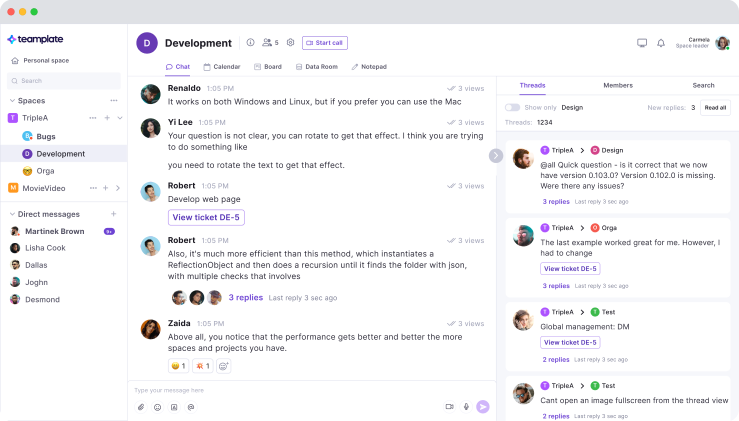
Teamplate is one of those very rare breed of startup tools – it’s 100% free for all your team members. You can access the most advanced features for free, and you can even invite external collaborators.
Let’s start with the very basics. As a startup, you’ll want your team to have access to the full host of essential office applications – we’re talking email, instant messaging, calendar scheduling, video conferencing and screen recording. To these you’re going to want to add workflow aides like project management, task tracking, and automation. Finally, you’re going to need a secure and reliable file sharing system, that also allows you to store directly on the platform. And, of course, a brainstorming space for those team sessions.
Teamplate offers them all. The best thing is that you won’t even need third party integrations, which is what most startup tools try to sell you. It does all of this from one interface, with one highly intuitive dashboard that gives you and your team access to everything. Looking for more? You don’t need a paid subscription to access any of the features, so it’s literally one of the best free online collaboration tools.
Star Features:
| Feature | Description | Use Case |
| Chat Integration | Real-time communication tool that allows you to convert messages into tasks, events, or notes, streamlining workflow without switching between multiple apps. | Enables quick task creation directly from conversations. |
| Kanban Board | Visual task management system with free Kanban board, including features like tickets, checklists, epics, and sprints to organize and track project progress. | Helps teams manage tasks efficiently, monitor progress, and maintain an organized workflow. |
| Calendar Integration | Space-based calendars that provide an overview of all project-related meetings and events, with options to create events directly or convert chat messages into meetings. | Ensures all team members are informed about schedules, reducing the risk of missed meetings. |
| Video Calls & Screen Sharing | Integrated video conferencing and screen sharing capabilities, allowing teams to connect and collaborate without the need for third-party applications. | Allows your team to conduct meetings and presentations seamlessly within the platform. |
| Personal Space | A dedicated area for individual users to manage their own personal tasks, events, and files, with customizable boards and data rooms. | Team members can organize their work and resources privately, enhancing personal productivity. |
| Data Room | Secure storage space for project-related files and documents, accessible to all team members within a project. | Centralizes important documents, ensuring easy access and collaboration among team members. |
Asana – Feature-Rich, But Learning Curve
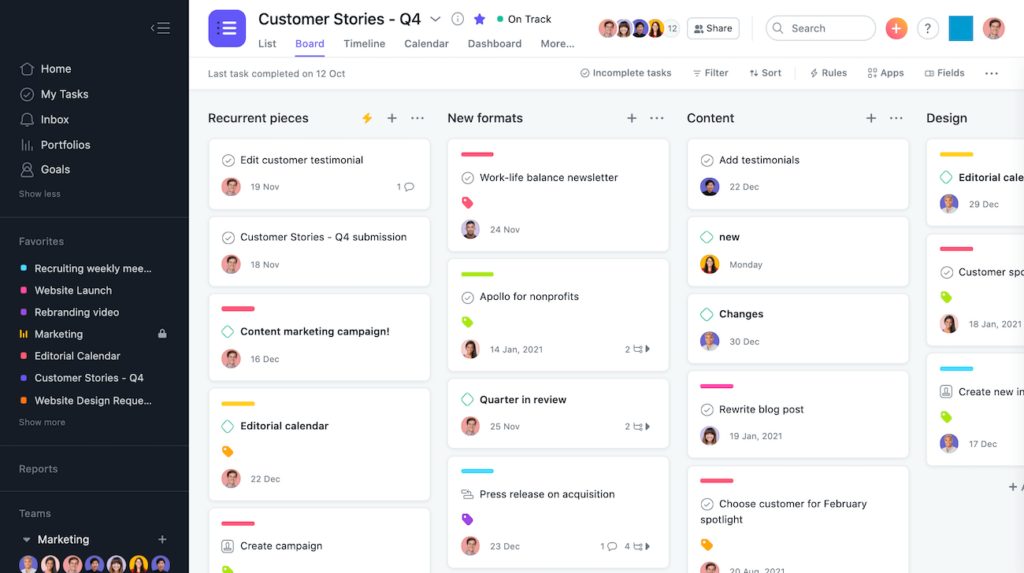
Asana a robust project management tool designed to help teams organize, track, and manage their work efficiently. It offers versatile features that help teams break down large projects into manageable tasks, assigning responsibilities, and setting deadlines.
Asana offers startup tools that are well-suited for teams of all sizes, and caters to a wide range of industries. The platform offers a free basic plan for individuals and small teams with limited needs, while premium startup tools features such as advanced reporting, automation, and timeline views are available at $10.99 per user/month when billed annually. For larger organizations, the Business plan at $24.99 per user/month includes additional tools like workload management and portfolio tracking. Custom pricing is available for enterprises needing more tailored solutions, including advanced security and support features.
Star Features:
| Feature | Description | Use Case |
| Task Dependencies | Allows team leads to define relationships between tasks, indicating which tasks are waiting on others, ensuring a clear sequence of work. | Helps teams manage complex projects by clarifying task order and preventing bottlenecks. |
| Custom Fields | Enables the addition of specific data fields to tasks and projects, so your team can track information like priority, status, or cost. | Provides flexibility to tailor Asana to your unique workflow needs, enhancing data organization. |
| Timeline View | Offers a Gantt-style visual representation of project tasks and deadlines, facilitating better planning and scheduling. | Helps you visualiza project progress, identifying potential delays, and adjusting plans accordingly. |
| Automation Rules | Allows users to automate routine tasks by setting up triggers and actions, reducing manual effort and increasing efficiency. | No more wasting your time assigning tasks or updating fields. |
Hubspot – Built for Marketing, Not All-Purpose
This all-in-one customer relationship management (CRM) platform offers a range of startup tools that help you scale your marketing, sales, and customer service efforts. Features range from email marketing and content management to customer support and advanced analytics.
HubSpot is ideal for small to mid-sized businesses as well as larger enterprises that need startup tools with a centralized CRM solution for a variety of task types, from managing leads to running automated marketing campaigns. The pricing structure is quite flexible, with a free CRM version that covers basic features also available. More advanced require the premium ‘Hubs’ – Marketing, Sales, Service, CMS, and Operations – which can be purchased individually or as a bundled package. Prices start from $50 per month for the Starter plans.
Star Features:
| Feature | Description | Use Case |
| Lead Scoring | Automatically ranks your leads based on their engagement and behavior, helping sales teams prioritize outreach efforts. | Enables sales teams to focus on high-potential prospects, increasing conversion rates. |
| Email Tracking | Notifies your team when emails are opened or links are clicked, providing insights into recipient engagement. | Allows you to gauge interest levels and tailor follow-up communications effectively. |
| Social Media Management | Integrates social media accounts for scheduling posts, monitoring interactions, and analyzing performance from a single dashboard. | Streamlines your social media marketing efforts, ensuring consistent brand presence and efficient engagement. |
| Content Management System (CMS) | Provides tools to create, edit, and optimize website content, with built-in SEO recommendations and analytics. | Empowers your marketing team to manage website content effectively, enhancing user experience and search engine visibility. |
Slack – Master of Communication, Task Management Lite
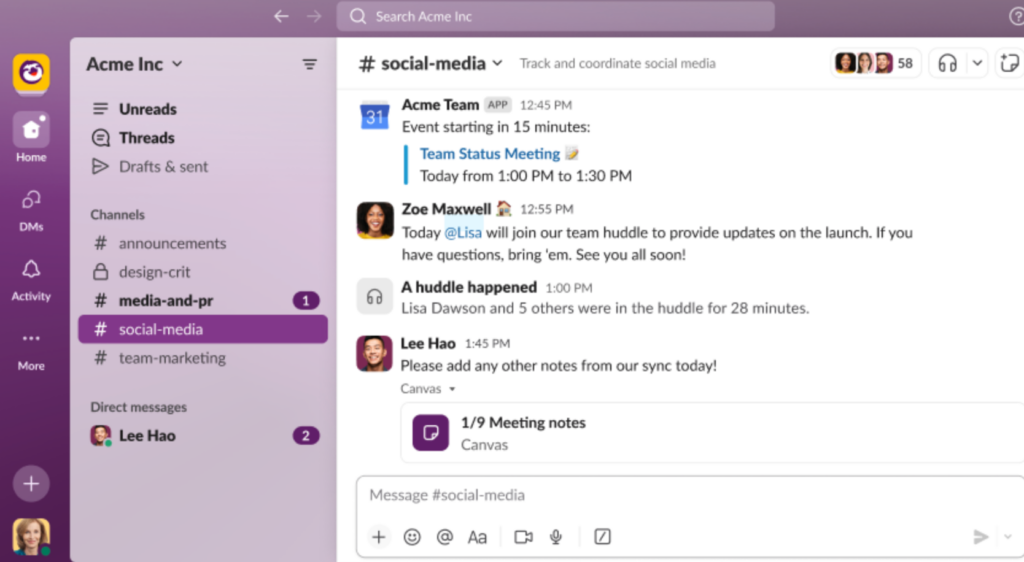
Slack is one of those suite of startup tools that focus on enhancing team collaboration and communication through real-time chat features, integrations, and customizable channels. Unlike traditional email, Slack it allow you to organize conversations by topic, project, or team by setting up dedicated channels.
The tool is well-suited for teams that work in fast-paced environments where immediate and fluid communication is crucial, and is particularly popular among tech companies and remote teams that need an efficient way to stay aligned on daily tasks and projects.
You can access a free version with limited startup tools and features, while the Standard, Plus, and Enterprise plans provide enhanced capabilities, such as greater message retention, increased integrations, and advanced security, making it adaptable to different team sizes and requirements.
The Pro plan is priced at $7.25 per user per month, while the Business+ plan costs $12.50 per user per month.
Star Features:
| Feature | Description | Use Case |
| Channels | Dedicated spaces for team conversations, organized by topics, projects, or departments, facilitating focused and organized communication. | Allows your teams to collaborate efficiently by keeping discussions relevant and accessible to appropriate members. |
| Slack Connect | Enables secure communication and collaboration with external organizations directly within Slack, replacing traditional email exchanges. | Facilitates seamless partnerships and client interactions by bringing all communications into a single platform. |
| Workflow Builder | A visual tool that allows users to automate routine tasks and processes without coding, streamlining workflows and increasing productivity. | Automates repetitive tasks such as onboarding new team members or gathering daily stand-up updates, saving time and reducing errors. |
| App Integrations | Supports integration with over 2,400 third-party applications, allowing you to bring your preferred tools and services into Slack for a unified workflow. | Notifications, data, and actions from various apps are centralized, reducing the need to switch between multiple platforms. |
Monday.com – Visually Appealing, Prone to Clutter
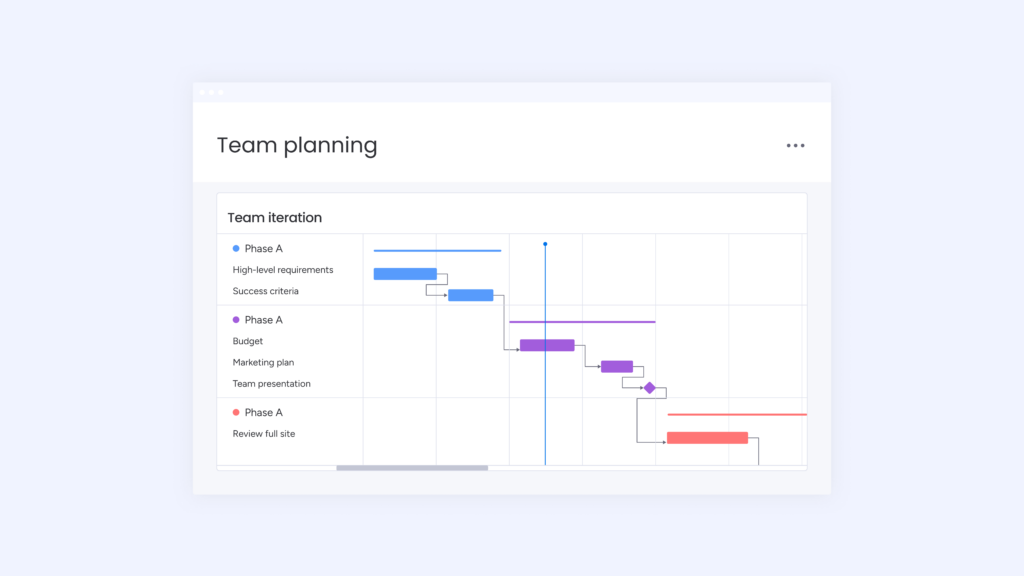
Monday.com is a versatile work operating system (Work OS) with a range of startup tools designed to manage projects, processes, and everyday tasks. It has an intuitive interface that makes use of various column types to capture essential data.
This project management software supports multiple views, including Kanban, Gantt, and calendar, and has the potential to scale up with you as you grow. It’s particularly suited to those seeking a flexible solution to coordinate complex projects and workflows, especially within the marketing, software development, and human resources sectors.
This is one of the top startup tools that allow for a free plan up to two users but free features are very basic. Paid plans start at $8 per seat per month, the Standard plan at $10 per seat per month, and the Pro plan at $16 per seat per month, all billed annually.
Star Features:
| Feature | Description | Use Case |
| Customizable Dashboards | Create personalized dashboards to visualize project data, track progress, and gain insights tailored to your team’s needs. | Enables your team to focus on key metrics and visualize project health at a glance. |
| Automations | Set up custom automation rules to streamline repetitive tasks, such as status updates and notifications. | Simplifies workflows by reducing manual effort, saving time on repetitive processes. |
| Integrations | Connect with third-party apps like Slack, Google Drive, and Microsoft Teams to centralize work processes. | Allows seamless collaboration by integrating tools your team already uses. |
| Time Tracking | Monitor the time spent on tasks directly within the platform for better resource management. | Helps you track team productivity and accurately estimate project timelines. |
Grammarly – Writing Savior, Project Management Novice
As startup tools go, this one is best suited for content-related roles. Grammarly is an AI-powered writing assistant that helps your team improve the quality, clarity, and tone of their writing across various contexts, including emails, documents, and social media posts.
Its user-friendly interface offers real-time grammar, spelling, and style suggestions, along with more advanced features like tone detection and readability scoring. Grammarly integrates smoothly with numerous platforms, such as web browsers, Microsoft Office, and Google Docs, allowing for consistent writing enhancement wherever it’s needed. The platform is ideal for professionals, students, and content creators aiming to produce polished, effective communication.
You can get a Free plan with essential grammar and spelling corrections, while the Premium plan, priced at $12 per month, includes advanced suggestions for tone, word choice, and engagement.
Star Features:
| Feature | Description | Use Case |
| Tone Detector | Analyzes your writing to identify the tone, helping ensure your message is conveyed as intended. | Helps you match the desired level of formality or friendliness. |
| Plagiarism Detection | Checks your text against billions of web pages and academic papers to identify potential plagiarism. | Ensures the originality of academic papers, articles, or any content requiring unique material. |
| Style Guide | Allows teams to create a customized set of writing guidelines to maintain consistent communication. | Helps your team ensure all written content aligns with the brand voice and standards. |
| Snippets | You can save and reuse commonly used phrases or responses to streamline communication. | Saves time for customer support teams by providing quick access to standard replies. |
Notion – Powerful Yet Pricey, Can Be Overwhelming
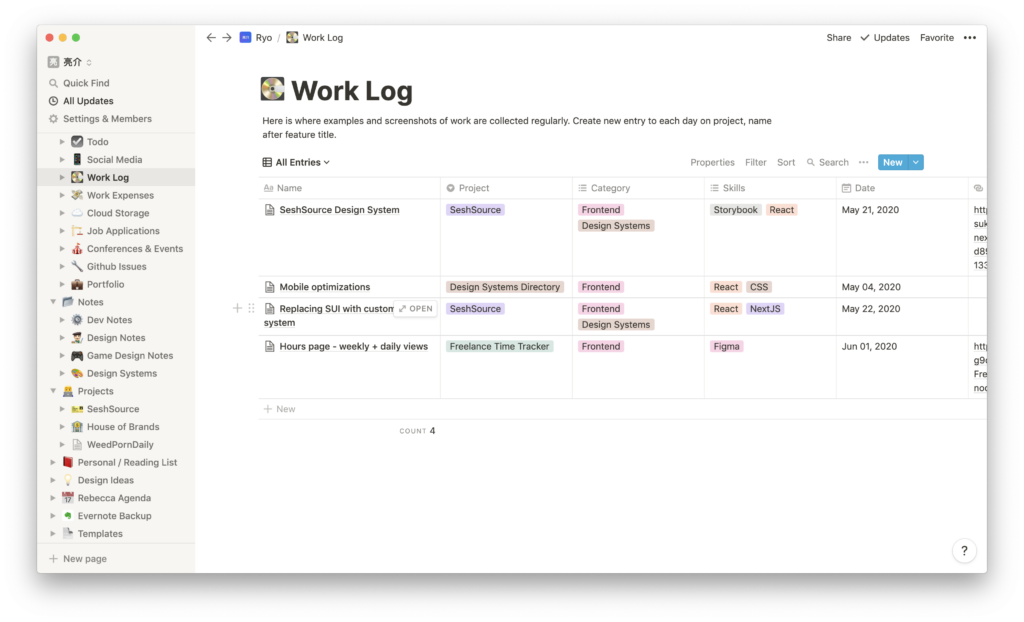
Notion combines note-taking, project management, databases, and collaboration tools into a single platform. You can create pages that include a mix of content types, such as text, tables, lists, and embedded media, making it easy to organize information in a way that suits individual or team needs.
It includes a solid range of startup tools designed to serve various industries and workers, from solo entrepreneurs needing a central place to track tasks and notes, to larger teams looking for a unified space to coordinate projects and share knowledge.
Notion, and other Notion alternatives, are well-suited to teams looking for startup tools related to content creation, product development, and education as the collaborative features make it easy to share documents, leave comments, and assign tasks. There’s a Free plan for individuals with limited block storage, while the Plus plan is priced at $8 per user per month. The Business plan, which includes more advanced features like admin tools, is available at $15 per user per month.
Star Features:
| Feature | Description | Use Case |
| Templates | Provides a vast library of pre-built templates for various purposes, including project management, note-taking, and personal planning. | Allows you to quickly set up structured pages tailored to specific needs, enhancing productivity. |
| Databases | Offers customizable databases that can be viewed as tables, boards, calendars, or lists, enabling efficient data organization and retrieval. | Makes complex data management tasks easy. |
| Integration with Other Tools | Supports integration with over 70 other SaaS tools, such as Slack, GitHub, GitLab, Zoom, Jira, Cisco Webex, Zapier, and Typeform. | Allows you to centralize their workflows by connecting Notion with other essential applications. |
| Notion AI | Uses artificial intelligence to help you with tasks like content generation, summarization, and translation. | Helps your team draft documents, generate ideas, or translate text directly within the platform. |
ClickUp – Feature Overload, Potential for Confusion
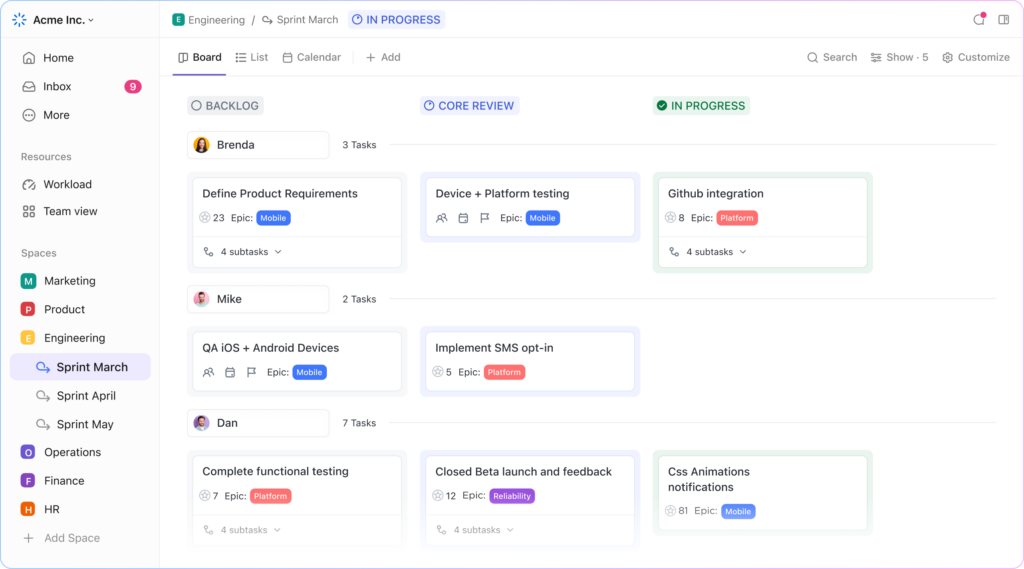
If you’re looking for startup tools that centralize task management, document collaboration, goal tracking, and time management, ClickUp offers precisely this. Its modular design allows users to tailor their workspace with features like custom fields, statuses, and views, accommodating diverse workflows and project requirements.
This software is very adaptable, so it’s suitable for sectors such as marketing, software development, and operations management. The pricing structure includes a Free Forever plan with essential features for personal use. However, teams would need to upgrade to a $7 subscription per user per month.
Star Features:
| Feature | Description | Use Case |
| Custom Task Types | Allows you to create and define unique task types to represent various work items, such as accounts, cases, or backlog items, tailored to specific workflows. | You can customize the task management system to align with your unique processes and project requirements. |
| Universal Search | Provides a comprehensive search functionality that enables you to find any file, whether it’s within ClickUp, a connected app, or a local drive, all from one place. | You gain quick access to necessary documents and information, reducing time spent searching across platforms. |
| Whiteboards | Offers a collaborative space where teams can brainstorm, plan, and visualize ideas in real-time, integrating tasks and content directly into the whiteboard. | Allows your team to engage in creative collaboration and strategic planning by providing a dynamic and interactive visual workspace. |
| Mind Maps | Enables you to create visual representations of ideas, tasks, and projects, facilitating better organization and understanding of complex information. | You can plan projects with a clear visual structure, using brainstorming sessions and a clear visual structure. |
Trello – Simple, Limited for Complex Projects
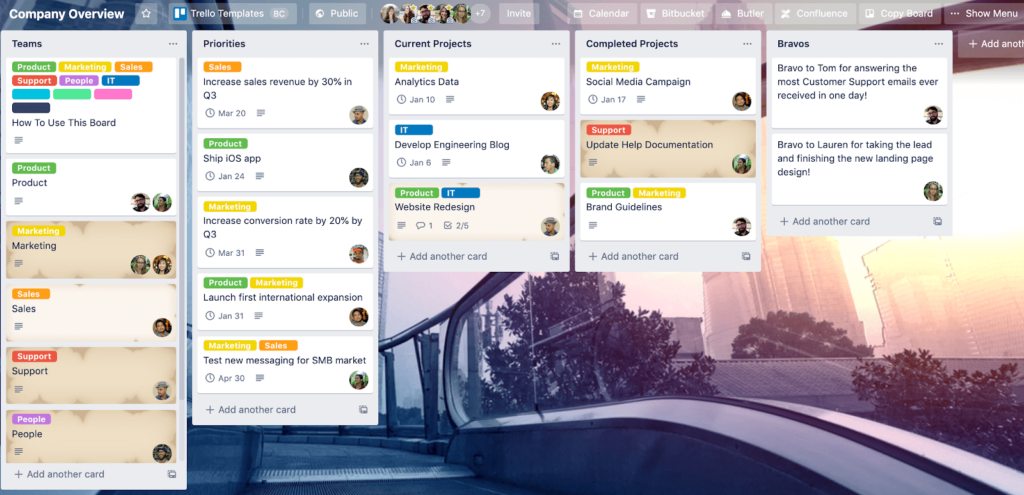
One of the most visual startup tools you can get is Trello, which uses a card and board system to help you organize tasks, collaborate, and track progress effortlessly. Its simplicity makes it accessible for a wide range of users who want to create and customize boards to categorize tasks. Moreover, its drag-and-drop functionality and checklist features enable easy updating and progress tracking/
Trello is usually preferred by teams that prefer startup tools with a straightforward approach to managing tasks and projects, and that don’t require complex dependencies. There’s a Free plan with essential features, a Standard plan at $5 per user per month, and a Premium plan at $10 per user per month billed annually.
Star Features:
| Feature | Description | Use Case |
| Butler Automation | A built-in automation tool that allows you to create custom rules, buttons, and commands to automate repetitive tasks and workflows without coding. | You can streamline processes such as moving cards between lists, setting due dates, and assigning members. |
| Power-Ups | Integrations that extend Trello’s functionality by connecting with external applications. | Allows you to add features like calendars, time tracking, and reporting through third party apps. |
| Advanced Checklists | Allows you to create checklists within cards, assign due dates and team members to individual checklist items, and track progress. | Helps you break down complex tasks into manageable steps, ensuring accountability and timely completion. |
| Card Covers and Colors | Allows you to add images or colors to card fronts, making it easier to identify and differentiate tasks at a glance. | You can navigate quickly between tasks without wasting time sourcing what you need. |
Why Do You Need Tools for Startups?
Having the right startup tools is something that you should start thinking about even before launch. The best way for a team to hit the ground is running – and we’d also add stress-free, and motivated.
If you haven’t planned ahead for the essential tools for startups, it’s going to be a case of limping, rather than running. And as for that stress-free environment, a bursting inbox and dozens of uncategorized chat threads never help.
How Startup Tools Like Teamplate Help You Stay Ahead of the Competition
Offering the full range of comprehensive startup tools, Teamplate provides the infrastructure to support your team’s growth and adaptability, allowing you to pivot as needed while maintaining efficiency.
The dashboard includes everything from project management to realtime communication, document sharing and storage, as well as calendar functions integrated into one cohesive platform. The only thing you need to do is enjoy the streamlined processes and watch productivity improve without stressing about it.
This centralized approach to startup tools not only simplifies operations but also reduces overhead costs, as multiple needs are all addressed by Teamplate, eliminating the need for piecemeal solutions.
The cherry on the cake? By leveraging automation and collaboration features, your team can gain an edge over competitors who are still relying on manual or disconnected processes. The startup tools included within Teamplate empower your teams to make informed decisions in real-time, ensuring rapid response to market changes, and fostering seamless communication across the organization.
Ultimately, using Teamplate can help you create a more agile business environment, providing a foundation for sustainable growth and competitive advantage.
Ready to start using the king of startup tools? Get in touch here.
More than ever, it has become a priority for organisation leaders to find the best remote team communication tools, ensuring seamless processes no matter where your employees are located. In the age of WFH (work from home) and hybrid offices, effective remote interactions are crucial.
In this guide we’re going to explain the features of must-have tools for remote teams, analysing the best on the market while comparing capabilities, prices and strengths. Let’s kick off with a quick explainer about the different types of communication software for remote teams.
Table of Contents

Types of Remote Team Communication Tools
What should you look for in the best remote team communication tools? There’s a mind-boggling array of software out there, which can complicate matters if you don’t have the time to trawl through (and understand) all the different tech specs. Below you’ll find the features you should look for when choosing virtual team communication apps, both for startups and medium-sized organisations.
Intuitive Software
If it takes too long to figure out, it’s going to stress out your team rather than help. Tools for remote teams should be intuitive, and easily mastered with one familiarisation session at most. They should also follow processes that most of us are already familiar with, such as dragging, pinning and the like.
Instant Messaging
You don’t want to have to schedule a meeting or send an email every time you want a quick response to a simple question. Instant messaging is the only way to facilitate immediate, informal communication and that allows both for one-to-one as well as group chats.
An integrated email service is essential for when you need to interact in a more formal manner. This removes the need to switch between different remote team communication tools.
Video Conferencing
This is a cornerstone of any remote team collaboration. The best software enables virtual meetings with reasonable time limits, while allowing for in-conference chats, presentations and session recordings.
Calendar Syncing
You want your team to find everything in one place, whether it’s emails, messages or calendar invites. It’s important to find remote team communication tools that include streamlined scheduling and timezone management, thus allowing for centralised planning and meeting integration.
Project Management Tools
The best communication software for remote teams includes reporting and collaboration features, so that employees can plan, schedule, offer feedback, share files, track their progress, and more – all from one hub.
The 10 Best Remote Team Communication Tools Ranked
Now you’ve got a good grasp on what you should look for in remote team software, we’re going to take a deep dive into the 10 top solutions currently available on the market.
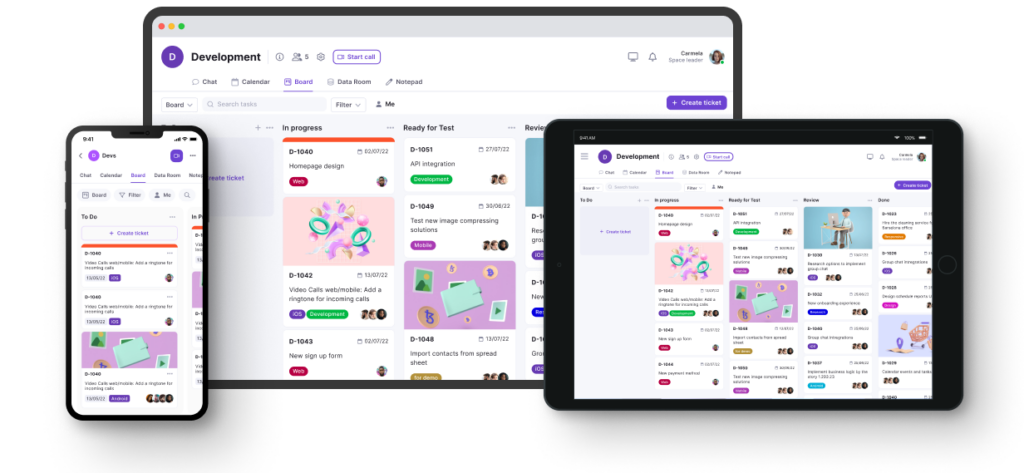
Teamplate
This state-of-the-art project management tool effectively integrates key business functionalities into a single platform that is as intuitive as it is advanced. All the main features that your team would need to use daily are included, such as Chat, Video Calls, Calendar, Board, Data Room, Space and more.
Each feature is designed to facilitate high-performance team dynamics and is adaptive to any department. Picture seamless collaborations, both within each department and across the different sections of your organisation. Teamplate makes it not only possible, but also simple, enabling entire companies to fulfil intricate workflow operations and to execute projects seamlessly.
The tool achieves this by using a versatile hierarchy framework that breaks down complex projects into individual tasks and subtasks within one integrated interface. You can scale a project up or, or down, as needed as the software comes with a comprehensive suite of advanced project management tools that help you maintain efficiency whether you’re an agile startup or an established powerhouse brand.
Price: Free
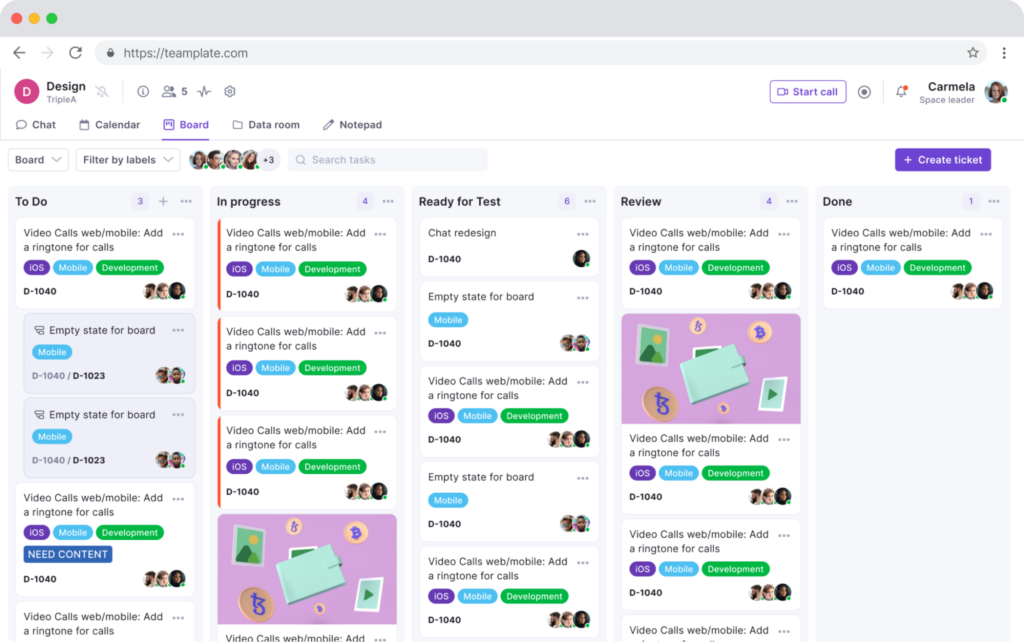
Standout Features
- Real-time communication through chat, including reactions, sharing, threaded replies and the option to turn chats into notes, tickets or events.
- High-definition video calls that transcend geographical locations and can be recorded.
- A separate Screen Record feature so you can offer feedback, articulate concepts and create visualisations.
- Boards, a Kanban-style task management system that allows you to administer and visualise tasks using features like Epics and Sprints.
- The Calendar function, where you can align all your team schedules and coordinate project timelines and deadlines from one central hub.
- A secure and organised Data Room that keeps sensitive information safe while making it accessible to team members who need it.
- Spaces for teams to categorise projects, clients and other ventures.
- A Personal Space for each team member to oversee their own task management.

Trello
This one’s more of a visual project management app than a central hub. Trello allows teams to work together on projects through the use of two different interfaces – Cards and Boards. Think of the Boards as different folders, where you can add different tasks on individual Cards.
Cards can be assigned to individual team members, and are equipped with a list of features to help the task owner and the assignee stay on top of the workflow. This is done by adding milestones, deadlines, checklists, attachments and more.
Price: $60 per user annually on the standard plan
Standout Features
- Drag and drop system adds flexibility and simplicity to the tasks.
- Can be integrated with Google Drive and Slack.
- Butler Automation takes care of recurring tasks, such as moving Cards to a completed column once they’re marked complete.
- Easy task assignment .
- Accessible on mobile, allowing for notifications and updates on the go.
Limitations
- No direct communication with other team members.
- No threaded conversations, making it harder to source specific information.
- Limited file-sharing capabilities.
- Doesn’t scale up due to lack of project management functionalities.

ClickUp
ClickUp lets you create tasks, subtasks, and projects which you can organise with different views such as List, Board, Calendar, Gantt and Timeline. It can be integrated with other tools like Slack, Google Drive and Zoom, allowing for real-time commenting and document sharing. It also supports features like goal and time tracking and task dependencies, providing control and oversight across complex projects.
Price: $144 per user annually on the Business Plan.
Standout Features
- Multiple view options that cater to different project management preferences.
- Customizable dashboards, workflows, and fields, tailored to specific project types.
- You can organise tasks with subtasks, nested checklists, task dependencies, and multi-task assignees, making it easier to manage complex projects.
- Robust reporting features so you can track team performance, task progress, time usage, and workload, offering valuable insights for project management.
Limitations
- This is one of those remote team communication tools that requires a steep Learning curve due to its extensive customization options and features.
- The wide array of features may feel excessive or unnecessarily complex, especially for smaller projects.
- There have been reports of slow loading times, especially when dealing with large projects or complex boards.
- Setting up new workspaces or workflows can be time-consuming due to the depth of options available, especially for new users.

Notion
Rather than a tool, Notion is a versatile, all-in-one workspace that combines note-taking, task management, database creation and project collaboration into a single platform. Pages are highly customisable, and you can present information through text, media, and other interactive elements like charts and tables.
It’s often described as the Wiki version of remote team communication tools, using a block-based system so you can easily rearrange and customise content. Features include nested pages, rich media embedding, and advanced permissions settings for collaboration.
Price: $96 per user annually
Standout Features
- Highly customizable pages with flexible layouts and full text, media and table capabilities.
- Blocks-based system: you can drag, drop and rearrange content easily, for stressless flexibility.
- Supports the creation of powerful databases, tables and spreadsheets for tracking information, organising tasks and managing projects.
- Nested pages can be created for content and taste that follow a clear hierarchy.
Limitations
- More well-suited for personal task management than advanced project management.
- There are no real-time collaboration features.
- The extreme flexibility and customisation options require in-depth familiarisation.
- Team pricing is quite steep.
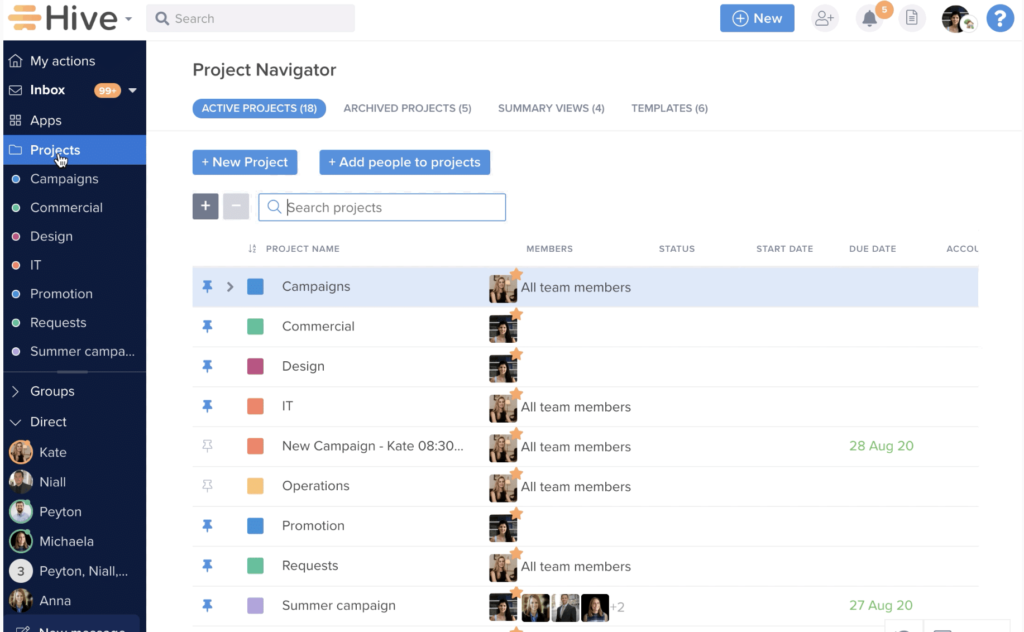
Hive
Hive is designed to streamline workflows for remote teams of all sizes, focusing on flexibility by offering multiple project views. It integrates seamlessly with popular tools like Zoom, Slack and Google Drive, so you can connect it to your existing workflows. It comes with built-in email integration to manage both internal tasks and external communications in one place, and offers real-time collaboration features such as proofing, approvals and commenting.
Price: $144 per user annually
Standout Features
- Multiple project views include Gantt charts, Kanban boards, calendars and tables.
- You can send and receive emails directly within the platform.
- Powerful automation features help to enhance productivity.
- Offers detailed analytics and reporting tools that give insights into project progress and overall performance, helping teams make data-driven decisions.
- Includes a built-in note-taking feature that supports meeting notes, collaborative document creation and team discussions.
Limitations
- Hive’s pricing can be expensive for small teams, especially when additional features like automation and analytics are needed.
- Loading time for large projects can suffer from lag.
- Automated tasks are quite complex to set up and require a steep learning curve.
- There is limited customization in reports so you might suffer trying to identify specific metrics or views.
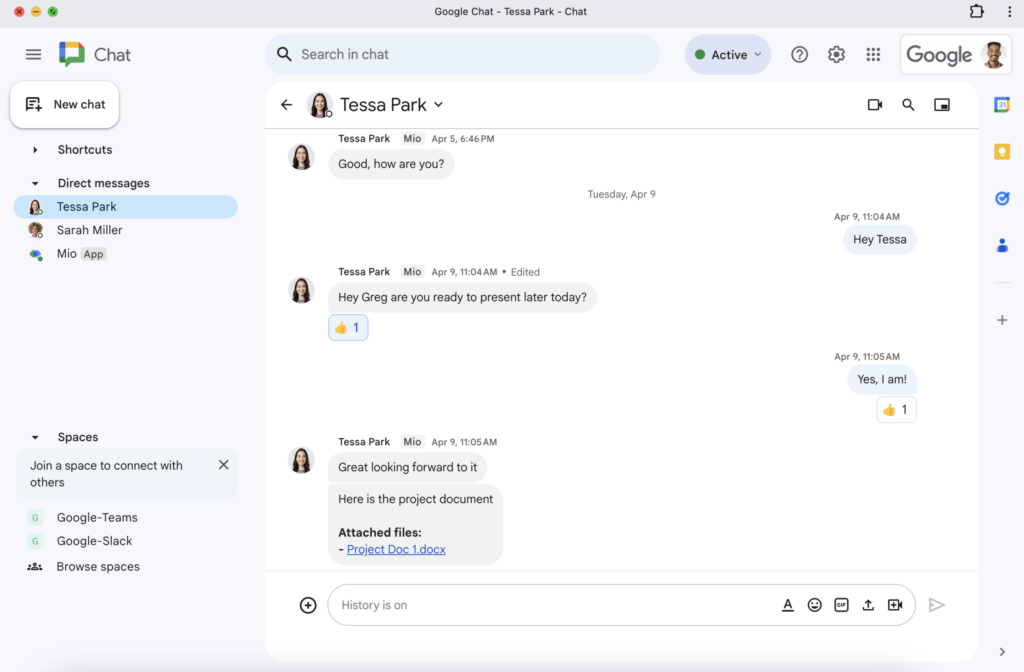
Google Meets/ Hangouts
This powerful communication platform allows you to engage in real-time conversations through messaging, voice, and video calls. It’s seamlessly integrated with other Google services like Gmail and Google Calendar, so it’s very easy to transition from email conversations to live chats or video meetings.
It supports both one-on-one and group conversations, and can synchronise across devices – you can start a conversation on your phone and continue it on your desktop without any glitches.
Price: Free
Standout Features
- Free voice and video calls up to 25 participants, providing an easy way to connect for both personal and professional purposes.
- Integrates with all other Google services, so you can easily switch between email, chat and video meetings.
- No software installation is required and you can access it directly from a web browser or mobile app, without the need for additional software installation.
- It’s free to use for both individuals and businesses, making it a cost-effective option for communication.
- SMS Integration (for mobile): Allows users to send and receive SMS text messages through the mobile app, providing a unified communication platform.
Limitations
- It only provides basic messaging and video calling, lacking integrated tools for managing tasks, setting reminders, or organizing projects.
- There are no threaded conversations, so it’s difficult to keep track of multiple projects or topics within a single chat.
- Group video calls are capped at 25 participants, making it unsuitable for larger organisations.
- It does not integrate well with third-party services and apps that aren’t Google.
- There are no built-in tools for collaboration, such as screen annotations, whiteboards, or file sharing during video calls.

Asana
This is one of the most powerful remote team communication tools, designed to help teams organise, track and manage their work efficiently. The interface is highly intuitive and flexible, making it easy to break down projects into tasks, assign them to team members, and track progress through customizable workflows.
It comes with built-in reporting, goal-setting and automation features to help teams stay aligned and productive, so it’s perfect for companies looking to improve project visibility and accountability.
Price: $131.88 per user annually
Standout Features
- Comes with pre-built templates for various project types, so teams can set up workflows quickly.
- The timeline view is excellent to aid project planning and visualise dependencies, deadlines, and long-term project goals.
- You can set up project milestones and set goals to monitor progress and keep teams aligned with larger objectives.
- The mobile app is extremely efficient, offering full functionality from your device.
Limitations
- There is no built-in time tracking, so you’ll need to rely on third-party integrations.
- Without careful organisation, it can be challenging to manage large volumes of tasks effectively.
- There is no built-in chat functionality.
- While Asana offers task dependencies, tracking them can become confusing in larger projects, especially when there are many linked tasks.
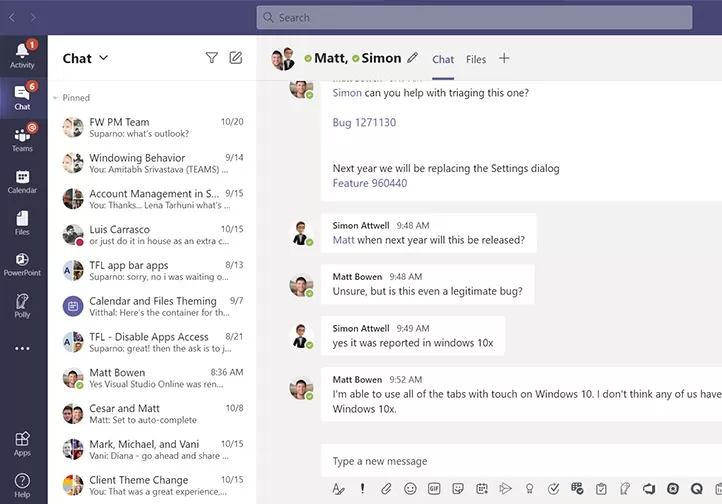
Microsoft Teams
Microsoft Teams stands out mainly thanks to its integration with the entire Microsoft 365 ecosystem, making it especially effective for organisations already using tools like SharePoint, OneDrive and Outlook.
This is one of the few remote team communication tools that can seamlessly transition from chat to full-scale project management and collaboration within a single platform. It has very strong meeting functionality with features like automatic transcription, breakout rooms and file sharing during video calls.
Price: $150 per user annually.
Standout Features
- Allows users to edit Word, Excel and PowerPoint documents collaboratively within the chat or meeting interface, with changes visible in real time.
- Integrated Microsoft 365 Ecosystem without leaving the Teams platform.
- Integrates with Microsoft Planner, allowing for built-in task assignment, tracking and project management within chat channels or meetings.
- Structured communication through private channels, organisation-wide teams and guest access, enabling complex workflows and collaboration across internal departments or external partners.
Limitations
- No native email integration – users must switch to Outlook for email-based communication.
- The search tool lacks advanced filtering options, so it’s difficult to find specific messages or files in large channels or chats.
- Microsoft Teams is resource-intensive, often consuming a significant amount of memory and CPU, which can affect the performance of other applications on lower-end devices.
- Inconsistent audio or video quality during calls, especially in larger meetings
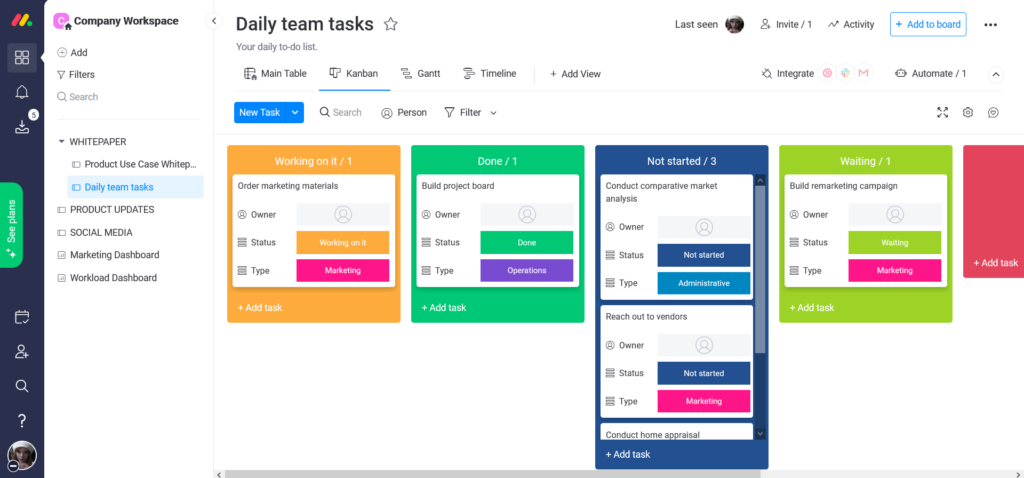
Monday.com
This app focuses on automating repetitive tasks and creating data-driven workflows without needing complex interventions by the user. The platform is highly flexible and includes advanced features like time tracking and task dependencies all in one place. It offers excellent scalability, making it suitable both for small teams and larger businesses that need to track complex projects and cross-departmental workflows.
Price: $120 per user annually
Standout Features
- Offers granular control over who can view, edit, and manage boards and workflows, making it ideal for teams that need strict permission settings across departments.
- Comes with advanced workload visualisation tools, allowing managers to monitor team capacity for even distribution of tasks.
- You can create highly specific notification rules triggered by changes in tasks, statuses, or deadlines, keeping the team aligned without getting overwhelmed.
- Supports columns for complex data types like numbers, progress bars, timelines, formula calculations and even team member availability.
Limitations
- Doesn’t support deep task hierarchies, making it difficult to manage complex projects with multiple layers of subtasks.
- The highly visual interface can become overwhelming when dealing with large projects or numerous boards.
- Lacks reporting customization and advanced analytics.
- Heavily reliant on third party integrations.
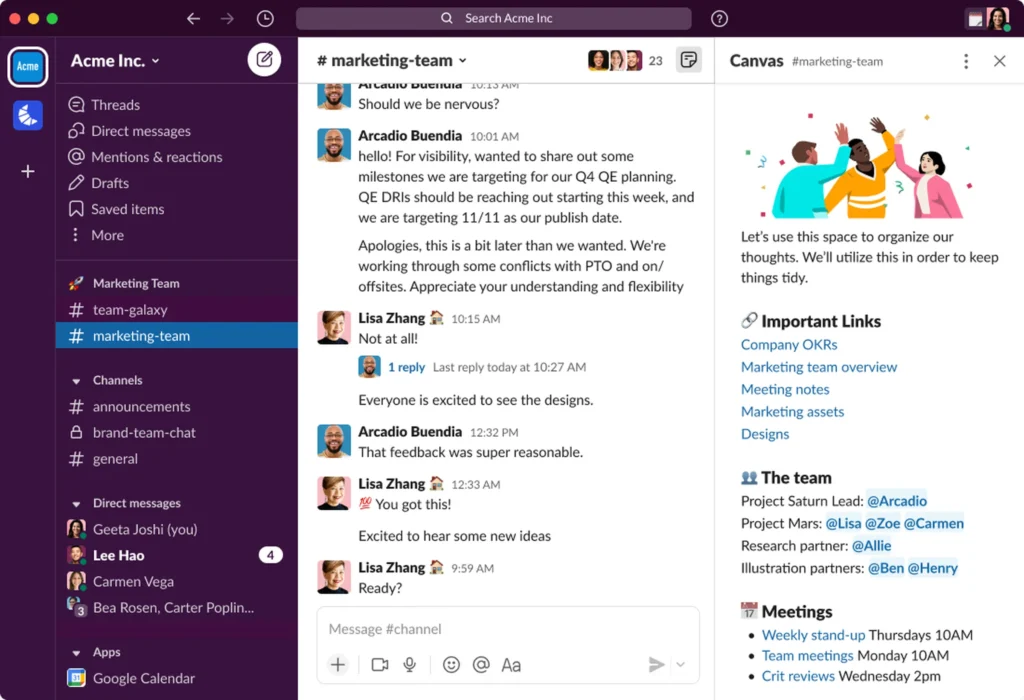
Slack
This is primarily a messaging forum aimed towards reducing the time spent on emails and maximising real-time communication. Team members join channels, which are like organised chat rooms focusing on different topics, projects, or departments. You can also send direct messages to individuals for private conversations. Slack also lets you share files, images and links, and integrates with other tools like Google Drive or Zoom.
Price: $150 per user annually.
Standout Features
- The Workflow Builder automates routine tasks by creating custom forms that trigger specific actions, like routing messages to designated channels.
- Searchable History allows for in-depth searches of messages, files, and even integrated app data to retrieve information across teams and conversations.
- Slack Connect enables secure collaboration with external partners by allowing multiple organisations to communicate in shared channels.
- The Huddle feature is a lightweight audio call for informal voice conversations within channels or direct messages, ideal for quick discussions.
Limitations
- Very costly for medium to large teams.
- There is no management of threaded conversations, resulting in difficulty to source information.
- No built-in project or task management.
- Video calls are available, but the quality is inconsistent.
Why is Virtual Communication Important for Remote Teams?
Easy communication in real time is important for any organisation to function properly, and not only within individual departments, but across the board. For traditional offices this was less of an issue, given that you could simply pick up the phone or drop by someone’s desk.
But for 21st century businesses, effective interactions need to be structured in a better way. Here are some of the challenges that can be easily solved via the right remote team communication tools.
Common Challenges Faced by Remote Teams
There are a number of issues that remote and hybrid teams face nowadays, and they can quickly affect productivity and morale unless tackled fast. These include:
- Different time zones
- No body language to guide you during interactions
- No conflict management or resolution
- Poor internet connectivity
- No physical oversight over teams
- A lack of company culture
The right remote team communication tools will address all the above. They also facilitate asynchronous communication, which is when there is a delay between when a message is sent and when it is received or responded to, allowing participants to focus and prioritise as needed.
Instant messages, emails and voice notes are excellent examples of ‘async communication’ and should be expected to feature in remote team communication tools.
How to Choose the Best Remote Team Communication Tools for You
You’ll have noticed that many of these solutions have very similar functions, so it can be difficult to identify which of the above remote team communication tools works best for your organisation.
Here’s the good news – there’s a short-cut to that. The below key questions will help you zoom in to which features are an absolute must for your business’s needs.
- What are your key requirements? Do you need project management, document sharing, a communication platform, or a combination of everything?
- Do you plan to scale up operations? If the answer is yes, scalability is critical so you’ll need to be able to add users and features.
- Is it easy to master or will the team require in-depth training? Cool features are nothing without the ability to use them.
- If you’re already using other tools, can these be integrated?
- How pricey is it? If it’s free, will you have access to all the features that you need or will you be hit by an unexpected cost?
Final Thoughts
Having the right remote team communication tools at your disposal is critical for the success of your projects. Mulling over the above points will help you zone in to your specific needs, while the below table makes it easier to compare the individual features without the need of investing too much time in research.
| Feature | Teamplate | Trello | ClickUp | Notion | Hive | Google Hangouts | Asana | Monday.com | Slack |
| Intuitive Software | ✓ | ✓ | ✓ | ✓ | ✓ | ✓ | ✓ | ✓ | ✓ |
| Instant Messaging | ✓ | ✓ | ✓ | ✓ | ✓ | ✓ | ✓ | ✓ | ✓ |
| ✓ | ✗ | ✗ | ✗ | ✓ | ✓ | ✗ | ✗ | ✓ | |
| Video Conferencing | ✓ | ✗ | ✓ | ✗ | ✓ | ✓ | ✗ | ✗ | ✓ |
| Calendar | ✓ | ✗ | ✓ | ✓ | ✓ | ✗ | ✓ | ✓ | ✗ |
| Project Management Tools | ✓ | ✓ | ✓ | ✓ | ✓ | ✗ | ✓ | ✓ | ✗ |
| Scalable | ✓ | ✓ | ✓ | ✓ | ✓ | ✗ | ✓ | ✓ | ✓ |
| All features available for free | ✓ | ✗ | ✗ | ✗ | ✗ | ✓ | ✗ | ✗ | ✗ |
Selecting the right project management tool is crucial for teams that want to enhance their workflow, collaborate efficiently, and deliver projects on time. Among the top contenders are Trello, Jira, and Asana—each with its own set of features and benefits. However, not all tools are built the same, and understanding their limitations is key to making an informed choice. Before we dive into the specifics of each tool, we’ll introduce the challenges teams often face when using multiple, disjointed platforms and how an all-in-one solution like Teamplate can solve these issues.
Table of Contents
Why Choosing the Right Project Management Tool Matters
In today’s work environment, efficiency and collaboration are paramount. The wrong project management tool can cause communication breakdowns, inefficient task handling, and missed deadlines. Many teams find themselves juggling multiple apps to cover project tracking, communication, and file management. This fragmented approach not only increases costs but also leads to context switching, where time is wasted moving between tools. By consolidating these functions, teams can simplify their workflows, enhance productivity, and reduce unnecessary expenses.
That’s where Teamplate stands out as a holistic solution—combining task management, collaboration, and communication features in one platform. Now, let’s compare Trello, Jira, and Asana before discussing how Teamplate offers a superior alternative.

Trello: Simple Kanban, But Limited
Strengths:
- Intuitive Kanban Boards: Trello’s visual interface is its biggest strength. The platform allows teams to manage tasks through its highly visual Kanban boards, where users can drag and drop tasks across customizable columns.
- Ease of Use: Trello’s simplicity makes it an excellent choice for individuals or small teams who need a lightweight task management solution. Setting up a project is quick, and the learning curve is minimal.
- Custom Power-Ups: Trello offers integrations known as Power-Ups, which let users add functionalities like calendars, automation, and reporting. This allows users to tailor Trello to their specific needs.
Weaknesses:
- Limited Native Features: Trello’s simplicity comes at the cost of functionality. Many essential features like task dependencies, reporting, and detailed project views are not built into the core product. Teams often need to rely on Power-Ups, which can increase complexity and costs.
- Scaling Issues: While Trello is great for small teams and projects, it struggles to handle more complex workflows. Larger teams or projects with many interdependencies often find Trello too basic for managing detailed processes.
Where Trello Falls Short:
Trello’s Kanban boards are effective for simple, small-scale projects, but they fall short when more complex management needs arise. As projects grow, the lack of advanced task tracking, workload management, and native collaboration features becomes a significant hurdle. Relying on Power-Ups to fill these gaps increases costs and forces teams to deal with multiple third-party solutions, which diminishes the simplicity Trello originally promises.
How Teamplate Wins:
Teamplate offers the same clean, easy-to-use Kanban boards that Trello users love, but with built-in advanced features—like task dependencies, project milestones, and collaborative tools—eliminating the need for additional Power-Ups. With Teamplate, you get comprehensive project management right out of the box, including real-time chat, video calls, and document sharing, so your team stays connected and efficient. Whether you’re managing a small project or a large, complex initiative, Teamplate provides the scalability and functionality needed to handle it all in one place.
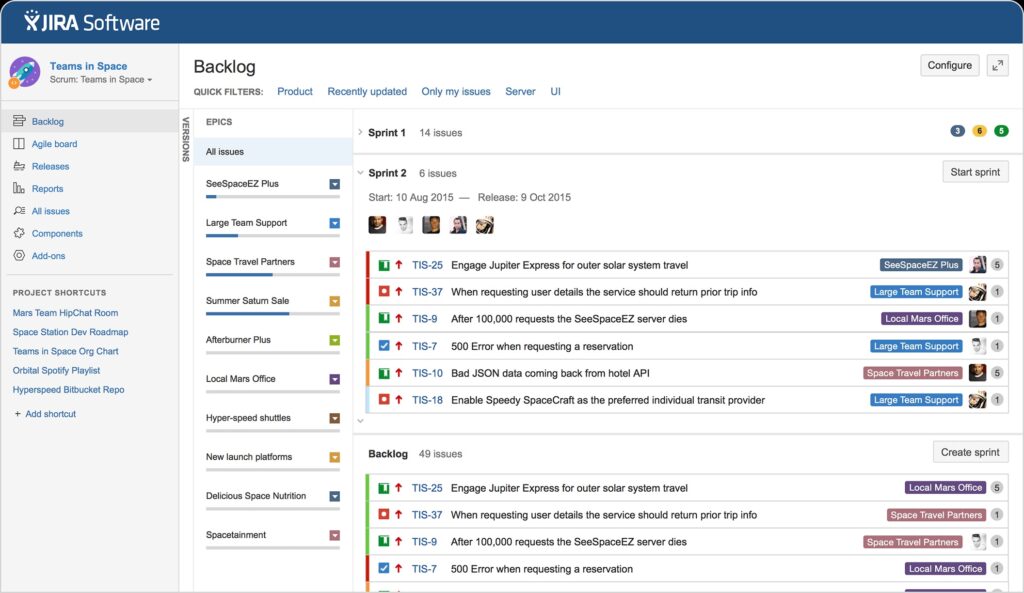
Jira: Built for Technical Teams and Complex Projects
Strengths:
- Ideal for Software Development: Jira is designed with developers in mind. It provides powerful tools for managing backlogs, sprints, and issues, making it a great fit for teams following Agile or Scrum methodologies.
- Customizable Workflows: Jira offers extensive customization options, allowing teams to create specific workflows tailored to their development needs. This level of control is one of Jira’s standout features.
- Detailed Reporting: Jira excels in offering a wide range of reports and dashboards, helping teams track progress, identify bottlenecks, and manage workload distribution effectively.
Weaknesses:
- Steep Learning Curve: Jira’s complexity can be intimidating, especially for non-technical teams. Its extensive feature set means that setup and maintenance require significant time and effort, which can be a drawback for smaller teams or projects.
- Too Specialized: While Jira is excellent for development teams, it can feel overly complex or even irrelevant for teams outside of the tech space. Non-development teams may find Jira’s features overkill for general project management.
Where Jira Falls Short:
Jira’s advanced features make it a powerful tool for software development teams, but its complexity limits its appeal to non-technical users. Teams without a background in Agile methodologies often struggle to navigate the tool’s many features, and the learning curve is steep. Additionally, for smaller, non-technical teams, Jira offers more than what’s necessary, leading to unnecessary complexity.
How Teamplate Wins:
Teamplate offers the project management strength of Jira, but without the intimidating complexity. It’s a versatile platform that supports a wide range of project management needs—whether you’re a technical team managing sprints or a marketing team planning campaigns. Teamplate’s advanced features, like epics, sprints, and workload management, provide the same depth as Jira, but in an intuitive interface that can be adopted by any team, regardless of technical expertise. With Teamplate, you won’t be overwhelmed by unnecessary features, but you’ll still have everything you need for both simple and complex projects.

Asana: Task Management for Teams of All Sizes
Strengths:
- Comprehensive Task Management: Asana excels at breaking down large projects into tasks and subtasks, making it easy for teams to assign, track, and complete work. Its user-friendly interface makes it accessible to teams of any size.
- Workload Balancing: Asana’s workload feature helps teams distribute tasks evenly, preventing team members from being overloaded. This makes it easier for managers to keep track of who is working on what.
- Multiple Project Views: Asana provides list views, calendar views, and timeline views, giving users flexibility in how they visualize their projects. This variety of views helps teams stay organized and focused on deadlines.
Weaknesses:
- Limited Free Plan: Asana’s free version offers only basic features. To access more advanced tools, such as automations and project timelines, teams need to upgrade to a premium plan, which can be costly for smaller teams.
- Integration Dependency: While Asana is feature-rich, many teams find themselves needing to integrate third-party tools to achieve full functionality. This can make the platform more complicated to manage over time.
Where Asana Falls Short:
Asana’s strength in task management makes it a popular choice, but its reliance on third-party integrations and its limited free plan can restrict its usefulness for smaller teams. Many essential features are locked behind a paywall, and scaling your team with Asana can quickly become costly. Additionally, the need for external integrations can lead to a fragmented experience.
How Teamplate Wins:
Teamplate offers the same task management power as Asana, but without the limitations of a tiered pricing structure. Teamplate’s freemium model grants access to all features right from the start, meaning you get everything—task assignments, multiple project views, workload balancing, and more—at no extra cost. Additionally, Teamplate’s built-in collaboration tools, such as video calls, group chat, and file sharing, reduce the need for third-party apps, allowing your team to stay focused and productive within a single platform.

How Teamplate Wins: A Comprehensive All-in-One Solution
While Trello, Jira, and Asana each have their strengths, Teamplate rises above as a powerful, integrated platform that solves many of the problems these tools cannot. Here’s a detailed look at why Teamplate is the ultimate project management solution for teams seeking simplicity, flexibility, and robust functionality without the high cost or complexity.
All-in-One Platform: No Need for Multiple Tools
One of the biggest frustrations teams face with Trello, Jira, and Asana is the need to juggle multiple tools to get a complete project management experience. You might use Trello for task management but need to integrate a communication tool for team discussions or use external apps for file storage and sharing. With Teamplate, you don’t need to rely on third-party integrations to get the job done—everything is built into one cohesive platform.
Key Features Include:
- Task Management & Kanban Boards: Just like Trello, Teamplate offers intuitive, drag-and-drop Kanban boards that allow you to visualize your workflow. But unlike Trello, you also get access to advanced project management features—such as task dependencies, project timelines, and backlog views—without needing any extra plugins.
- Collaboration Tools: Teamplate is equipped with built-in chat, video calling, and file sharing, making collaboration seamless. Your team can work together on tasks, discuss projects in real time, and share documents or meeting recordings—all without needing external apps like Slack or Zoom.
- Project Views: Much like Asana, Teamplate offers multiple ways to view your project, including calendar, list, and Kanban views. These versatile options allow you to track your tasks and deadlines in whatever way works best for your team.
- Workload Management: Managing team workloads is crucial for productivity, and Teamplate includes built-in tools that allow you to balance workloads across your team. This feature ensures that no team member is overloaded with tasks, helping you meet deadlines more effectively.
Simplified User Experience: Easy to Adopt, No Learning Curve
Jira’s complexity and steep learning curve can be a serious drawback for teams that don’t have a technical background. Teamplate offers powerful functionality without sacrificing simplicity. Its intuitive interface allows teams to start using the platform immediately without lengthy onboarding or extensive training. Whether you’re managing a development sprint, marketing campaign, or internal business process, Teamplate makes it easy to get started.
Advanced Features Without the Complexity or Cost
While Jira excels at managing technical development projects, its extensive customization options can overwhelm smaller teams or non-developers. Similarly, Asana and Trello often require costly upgrades to access their best features. Teamplate’s freemium model solves this problem by providing access to all features from day one—no hidden costs, no need for third-party integrations, and no complicated pricing tiers.
With Teamplate, you get:
- Comprehensive Project Management: Manage your projects with epics, sprints, and milestones for larger initiatives, all within a single platform.
- Secure File Storage: The data room allows teams to store and share files securely, with permission settings that let you control who has access to sensitive documents.
- Real-Time Communication: Instantly communicate with your team using the built-in chat and video call features. Collaborate on tasks or projects, and keep everything centralized in the same platform where your tasks are being managed.
- Calendar Integration: Keep track of deadlines, set meetings, and plan projects with Teamplate’s built-in calendar. This feature integrates directly with your task management system, so you never lose sight of important dates.
Scalable for Teams of All Sizes
Unlike Trello, which struggles with scalability, and Jira, which may feel like overkill for non-technical teams, Teamplate is designed to grow with your team. Whether you’re a small team of five or a large organization, Teamplate offers features and functionality that scale with your needs. From simple task management to complex multi-team projects, Teamplate’s adaptability makes it the right choice for businesses of all sizes and industries.
Cost-Effective and Accessible
With Teamplate’s freemium model, you don’t have to worry about expensive upgrades to access essential features. Unlike Asana, which limits its free users, Teamplate gives you full access to its suite of tools—whether you’re a freelancer, a small business, or a large enterprise. This affordability ensures that even small teams can benefit from top-tier project management features without breaking the bank.
How Teamplate Stands Out:
- All-in-One Solution: Task management, collaboration, file storage, and communication all in one place—no third-party integrations needed.
- Freemium Model: Full access to all features without hidden costs or premium plans, making it ideal for teams of all sizes.
- User-Friendly Interface: Easy to adopt, with an intuitive design that minimizes training and onboarding time.
- Scalable: Whether managing a small project or a large initiative, Teamplate scales seamlessly to fit your team’s needs.

Conclusion: Choose the Right Tool for Your Team
Each of these project management tools—Trello, Jira, and Asana—has its strengths, but they also have limitations that can make them challenging for certain teams. Trello is easy to use but lacks depth, Jira is powerful but overly complex for non-technical teams, and Asana is a solid task management tool but can quickly become expensive as your team grows.
Teamplate stands out by offering an all-in-one solution that brings together the strengths of all three platforms, without the drawbacks. Whether your team needs advanced project tracking, seamless collaboration, or powerful task management, Teamplate delivers it all in a simple, intuitive platform. With Teamplate’s freemium model, you get access to every feature from day one, making it the best choice for teams of all sizes.Sign up for Teamplate today and experience the difference for yourself. Start managing your projects more effectively and see why teams of all sizes are making the switch.
Are you deciding between ClickUp and Trello for your project management needs? You’ve come to the right place.
Trello is well-known for its simplicity and visual approach to task management, making it a favorite among teams that prefer a straightforward, intuitive tool. With its familiar board, list, and card setup, Trello has gained widespread popularity as an easy-to-use project management solution.
ClickUp, on the other hand, is a newer contender in the productivity software space but has quickly made a name for itself by offering a comprehensive suite of features designed to manage everything from simple tasks to complex projects. With its robust customization options and wide array of tools, ClickUp is rapidly becoming a go-to choice for teams that need more flexibility and control.
But which tool is the right choice for your team? In this article, we’ll explore the strengths and weaknesses of both ClickUp and Trello—and introduce you to Teamplate, another powerful option that might just be the perfect fit for your team.
Table of Contents
Comparing ClickUp and Trello
ClickUp and Trello both offer strong solutions for managing tasks and projects, but they cater to different needs and preferences.
- Trello is ideal for teams that need a simple, visual tool to manage their tasks. Its board, list, and card system is easy to understand and highly effective for straightforward task management.
- ClickUp is designed for teams that require a more feature-rich platform. With its extensive customization options, multiple views, and advanced tools, ClickUp can handle a wide range of project management needs, from the simplest tasks to the most complex workflows.
The choice between these two tools depends on what your team values most—simplicity or comprehensive functionality. If you’re torn between ClickUp and Trello, it’s worth considering that there may be other options that could better meet your team’s specific requirements.
Let’s take a closer look at what ClickUp and Trello have to offer by examining their key features, strengths, limitations, pricing, and user reviews. We’ll also introduce Teamplate, another versatile option you may want to consider.

ClickUp Overview
ClickUp is an all-in-one project management platform designed to accommodate the needs of various teams, whether managing small tasks or complex projects.
Key Features:
- Multiple Views: ClickUp offers a variety of views including lists, boards, Gantt charts, calendars, and timelines, allowing teams to manage projects in the way that suits them best.
- Task Management: Create tasks, set priorities, and track progress with ease. ClickUp’s task management features are highly customizable, making it easy to tailor the workflow to your team’s needs.
- Time Tracking: Built-in time tracking allows you to monitor how much time is spent on each task, helping to improve productivity and efficiency.
- Automation: Automate repetitive tasks and processes to save time and reduce manual work.
- Integrations: ClickUp integrates with a wide range of other tools, making it easy to connect your existing software and streamline your workflow.
Best For:
- Teams that need a feature-rich platform capable of handling both simple and complex project management tasks.
- Organizations that value customization and require advanced tools to manage their projects effectively.

Trello Overview
Trello is a straightforward and visually-driven project management tool that simplifies task management for teams of all sizes.
Key Features:
- Boards, Lists, and Cards: Trello’s simple setup makes it easy to organize tasks and projects in a visual and intuitive way.
- Customizable Labels: Use color-coded labels to categorize tasks, making it easy to prioritize work.
- Integrations: Enhance Trello’s functionality with integrations that connect it to other tools your team uses.
- Butler Automation: Automate routine tasks with Trello’s built-in automation tool, Butler, to save time and improve efficiency.
Best For:
- Teams that prefer a simple, visual approach to managing tasks and projects.
- Small-to-medium teams looking for an easy-to-use project management tool that doesn’t overwhelm with too many features.

Introducing Teamplate: The All-in-One Collaboration Tool for Your Team
In today’s fast-paced work environment, finding a tool that integrates all the features your team needs can be challenging. That’s where Teamplate comes in—a user-friendly, all-in-one collaboration platform designed for smaller-scale companies. Teamplate was created to compete with leading tools like Slack, Zoom, Jira, and Confluence, by bringing together the best elements of these tools into a single, cohesive platform. This eliminates the need for constant context switching, allowing your team to focus on what truly matters: getting things done.
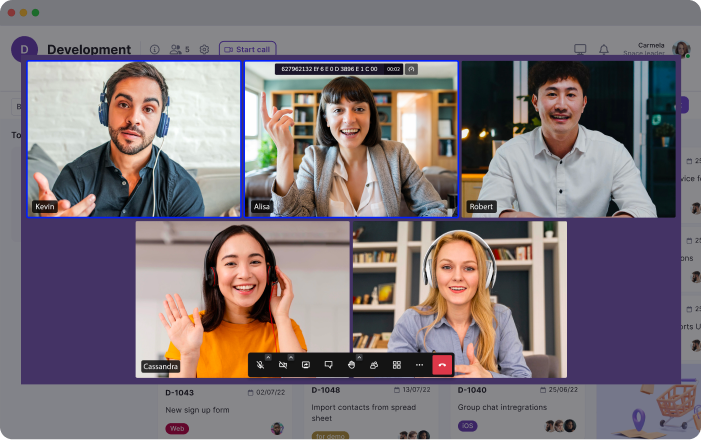
Why Choose Teamplate?
- Increase Productivity: Teamplate reduces the need to switch between multiple apps by consolidating all your communication and project management needs into one platform.
- Save Time & Money: With everything in one place, you can streamline your workflow and reduce subscription costs by using a single tool instead of multiple services.
- Empower Your Team: Teamplate’s unified platform facilitates seamless collaboration, keeping all team interactions connected and organized.
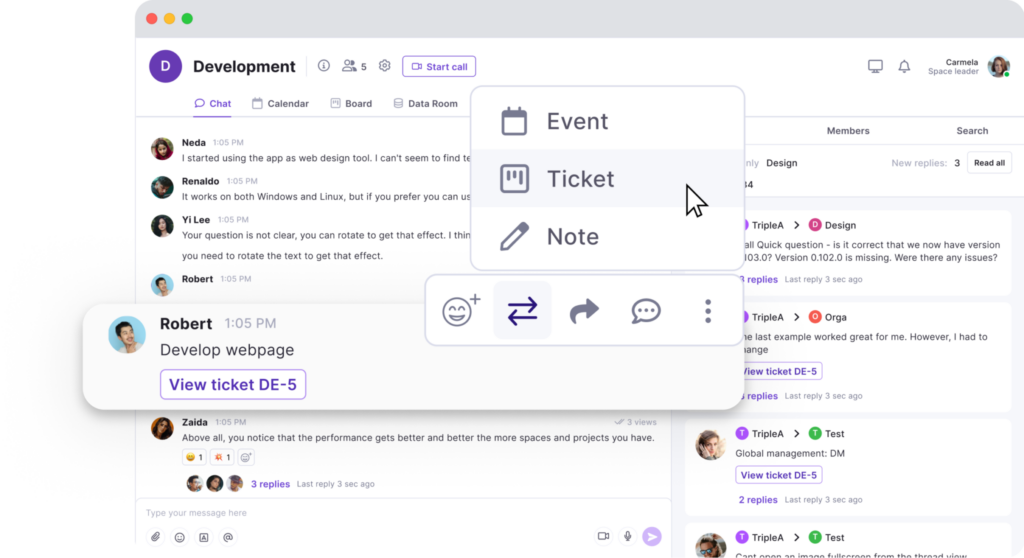
Teamplate’s Key Features:
Teamplate is designed to be a robust all-in-one collaboration and project management tool. Here’s a closer look at its standout features:
- Chat:
Seamlessly communicate with your team and clients across projects and spaces. Enjoy real-time messaging, file sharing, and threaded conversations to keep everyone aligned. - Video Calls:
Conduct efficient meetings with integrated video call functionality, perfect for remote collaboration. Screen recording capabilities allow you to capture and share important discussions. - Screen Recording:
Record your screen and easily share recordings within chats, tickets, or the data room. This feature is ideal for walkthroughs and documentation. - Kanban Boards:
Organize tasks and visualize progress with customizable Kanban boards, epics, and sprints. Flexibly switch between backlog, Kanban, and board views to match your workflow. - Calendar:
Manage meetings and deadlines effortlessly with an integrated calendar that syncs with your tasks and events. - Data Room:
Securely store, upload, and share files in various formats, with customizable permissions to control access. - Wiki & Notes:
Capture and share ideas, meeting notes, and important information with your team using the Wiki feature. The Notes feature acts as your personal notepad, visible only to you. - Dashboard:
Get a clear overview of your tasks, events, and data from a centralized dashboard that keeps everything organized in one place.
ClickUp vs Trello: Which Tool Should You Choose?
When choosing between ClickUp and Trello, the best choice depends on your team’s specific needs and the type of projects you handle.
- ClickUp: Best for teams that require a comprehensive, customizable platform with advanced features. If your projects are complex and need a tool that can be tailored to fit your specific workflow, ClickUp might be the right choice.
- Trello: Ideal for teams that need a simple, visual tool to manage tasks and projects. Trello is especially suited for smaller teams or those who prefer an easy-to-use, effective project management solution.
However, if you’re looking for a solution that combines the strengths of both ClickUp and Trello—without the need for multiple apps—Teamplate could be the optimal choice. Teamplate offers the customization and collaborative features of ClickUp, along with the simplicity and visual organization of Trello, all within a single, intuitive platform.

Why Teamplate Might Be the Best Choice
- All-in-One Solution: Unlike ClickUp and Trello, which may require integrations to achieve full functionality, Teamplate provides a complete suite of tools in one platform, simplifying your workflow and reducing the need for context switching.
- Seamless Collaboration: With integrated features like chat, video calls, screen recording, and Kanban boards, Teamplate delivers a smooth communication and project management experience that keeps your team focused and connected.
- Cost-Effective: Teamplate’s freemium model ensures you get all the essential features without the need for multiple costly subscriptions, making it a more affordable option for small-to-medium teams.
Ultimately, the best tool for your team depends on what you value most. If you need a powerful, customizable tool, ClickUp is excellent. If you prefer a simple, visual organizer, Trello is a great option. But if you’re looking for an all-encompassing platform that reduces complexity and enhances productivity, Teamplate might just be the perfect fit.
Are you torn between Trello and Notion for your team’s project management needs? You’ve come to the right place.
Trello has been a trusted choice for teams that need a straightforward, visual method to organize tasks and projects. With its simple interface centered around boards, lists, and cards, Trello has earned the loyalty of millions of users worldwide, becoming a staple in project management.
Notion, although newer in the productivity software arena, is quickly making a name for itself with its versatility and innovative approach. It’s an all-in-one workspace that combines note-taking, task management, and project planning, making it a formidable contender in the realm of productivity tools.
But is either tool the perfect fit for your team? Or could there be a better option tailored to your specific needs? In this article, we’ll break down the strengths and limitations of both Trello and Notion—and introduce you to Teamplate, an alternative that could be the ideal solution for your team.
Table of Contents
Comparing Trello and Notion
Both Trello and Notion offer powerful solutions for task management and team collaboration. However, they differ significantly in design, features, and the types of users they cater to.
- Trello is a simple, visual tool designed to help teams organize tasks and projects. Its user-friendly approach with boards, lists, and cards makes it easy for teams to see their work at a glance and manage tasks efficiently.
- Notion is a multifaceted tool that adapts to a wide variety of project management and documentation needs. Whether managing simple tasks or complex projects, Notion provides a flexible structure that can be customized to fit any workflow.
The choice between these tools ultimately depends on your team’s specific needs, preferences, and how you like to work. Keep in mind, there isn’t a universal solution for productivity software. If you find it difficult to decide between Trello and Notion, it’s worth considering that other tools might better suit your team’s unique requirements.
Let’s take a closer look at what Trello and Notion bring to the table by examining their key features, strengths, limitations, pricing, and user feedback. We’ll also introduce Teamplate, another powerful option that could be just what your team needs.
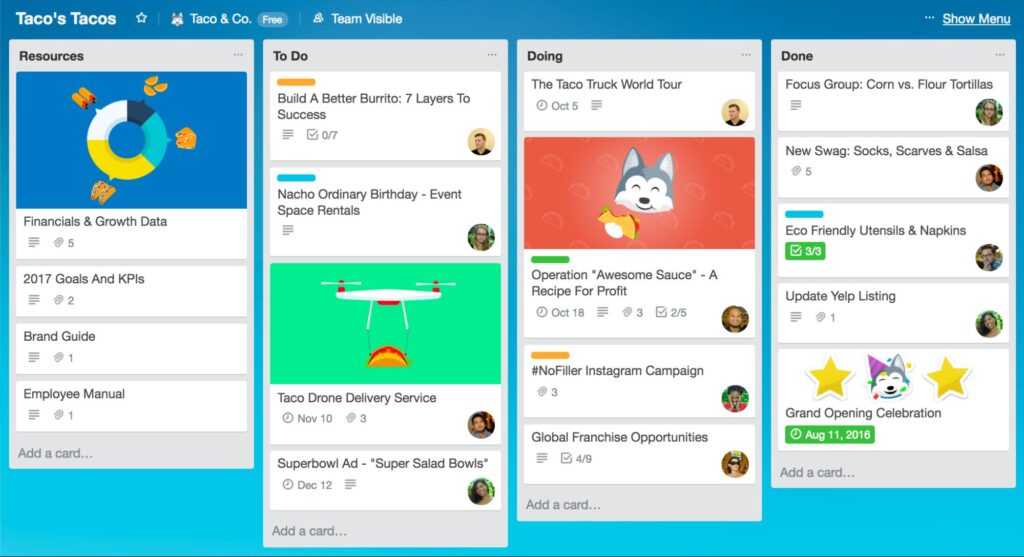
Trello Overview
Trello is a highly visual and easy-to-use project management tool that simplifies task management for teams of all sizes.
Key Features:
- Boards, Lists, and Cards: Visualize and organize your tasks and projects in a simple, intuitive way.
- Customizable Labels: Use color-coded labels to easily categorize and prioritize your work.
- Integrations: Enhance Trello’s functionality with integrations to a wide range of other tools.
- Butler Automation: Automate repetitive tasks with Trello’s built-in automation tool, Butler.
Best For:
- Teams that prefer a straightforward, visual approach to organizing tasks and projects.
- Small-to-medium teams looking for an uncomplicated, effective project management tool.

Notion Overview
Notion is a versatile tool that combines project management, documentation, and note-taking into one powerful platform.
Key Features:
- Project Dashboards: Customize dashboards to create a clear visual overview of your projects.
- Multiple Views: Manage tasks using lists, grids, calendars, and Kanban boards tailored to your needs.
- File Sharing and Collaboration: Work together on documents and share files seamlessly.
- Centralized Repository: Store and manage all your documents, SOPs, and handbooks in one easily accessible place.
Best For:
- Teams that need flexibility in managing both projects and extensive documentation.
- Small-to-medium teams that appreciate a highly customizable workspace.

Introducing Teamplate: The Ultimate All-in-One Collaboration Tool
In the fast-moving world of project management and team collaboration, finding a tool that integrates all the necessary features can be challenging. That’s where Teamplate comes in—a user-friendly, all-in-one platform specifically designed for smaller-scale companies. Teamplate was created to rival industry giants like Slack, Zoom, Jira, and Confluence, by bringing together the best elements of these tools into a single, cohesive platform. This eliminates the hassle of switching between multiple apps, allowing you and your team to focus on what’s most important: getting work done.
Why Choose Teamplate?
- Increase Productivity: With Teamplate, you can consolidate your tools into one platform, reducing the need for constant switching between apps.
- Save Time & Money: Teamplate helps you streamline your workflow by bringing all your communication and project management tools under one roof, saving you both time and subscription costs.
- Empower Your Team: Facilitate effective collaboration with a unified platform that ensures all team interactions are connected and streamlined.

Teamplate’s Key Features:
- Chat: Communicate effortlessly with your team and clients across various projects and spaces.
- Video Calls: Conduct efficient meetings with built-in video call functionality, perfect for remote collaboration.
- Screen Recording: Capture and share important discussions with screen recording capabilities that integrate directly into your projects.
- Kanban Boards: Organize tasks, manage workflows, and track progress with customizable Kanban boards, epics, and sprints.
- Calendar: Keep your schedule in check and manage meetings with ease using the integrated calendar.
- Data Room: Securely store, upload, and share files of various formats with controlled access.
- Wiki & Notes: Store and share key ideas, meeting notes, and important information with your team using the Wiki feature, and keep your personal notes organized with the Notes feature.
- Dashboard: Get a clear overview of your tasks, events, and data from a centralized dashboard that keeps everything in one place.

Trello vs Notion: Which Tool Should You Choose?
When it comes to choosing between Trello and Notion, the best choice depends on your team’s specific needs and the type of projects you handle.
- Trello: Ideal for teams that need a simple, visual tool to manage tasks and projects. It’s especially suited for smaller teams or those who prefer a straightforward project management solution.
- Notion: Perfect for teams that require a versatile tool capable of handling both project management and documentation. If your team values customization and flexibility, Notion might be the right fit.
However, if you’re looking for a solution that combines the best features of both tools—without the need for multiple apps—Teamplate could be the optimal choice. Teamplate offers the flexibility and collaborative features of Notion, along with the project management capabilities of Trello, all within a single, intuitive platform.
Why Teamplate Might Be the Best Choice
- All-in-One Solution: Unlike Trello and Notion, which may require additional integrations to reach their full potential, Teamplate provides a complete suite of tools in one platform, reducing the need for context switching and simplifying your workflow.
- Seamless Collaboration: With integrated features like chat, video calls, screen recording, and Kanban boards, Teamplate delivers a smooth communication and project management experience that keeps your team focused and connected.
- Cost-Effective: Teamplate’s freemium model ensures you get all the essential features without the need for multiple costly subscriptions, making it a more affordable option for small-to-medium teams.
Ultimately, the best tool for your team depends on what you value most. If you need a simple, visual organizer, Trello is a great option. If you prioritize flexibility and customization, Notion is a solid choice. But if you want an all-encompassing platform that reduces complexity and boosts productivity, Teamplate might just be the perfect fit.
Are you constantly on the lookout for a better way to get things done? If so, you’re likely familiar with free agile tools and how they can unify your team. A well-chosen agile project management tool can truly bring out the best in your team when implemented effectively.
In simple terms, agile software can make your work life smoother. However, it can also present challenges for teams. Surprised? Let me explain.
Think about the fall season. Have you noticed how trees, under stress, reveal a stunning array of vivid colors? Agile project management works similarly—it pushes teams to research, test, and adapt. When your team finds a free agile board that makes their work easier and more efficient, you know you’ve found a winning product.
To make your team truly agile, it’s essential to choose the right agile project management tool. With so many options out there, it’s easy to feel overwhelmed. That’s why we’ve handpicked the best free agile software solutions that you should consider for your next project. Let’s dive in!
Table of Contents
Why Choose Free Agile Tools?
Agile has become a powerful approach among tech professionals worldwide, offering an effective way to think and work. With the right free agile tools, your team can self-organize while managing specific tasks and projects, leading to improved communication, flexibility, and adaptability.
In today’s fast-paced world of product management, free agile software streamlines your team’s operations, enabling you to quickly deliver user-friendly and cost-effective products. With the right tools, your team can foster loyal customer relationships and efficiently analyze feedback from end-users.
As the name suggests, an agile work culture thrives on speed and efficiency. A robust free agile board ensures your project stays on track, avoiding unnecessary chaos. Once you find the right free agile tool for your scrum team, it becomes the cornerstone of your project’s success.
5 Best & Most Useful Free Agile Tools for Your Scrum Team
This article highlights a curated list of free Agile tools that project managers can use to enhance decision-making, boost collaboration and communication, identify risks early, and drive productivity.
1. Asana
A collaborative work management tool that helps teams track tasks, deadlines, and projects in one place.
2. Atlassian Jira
A robust software development tool that supports agile methodologies like Scrum and Kanban.
3. Trello
A visual project management tool with boards, lists, and cards that make tracking tasks simple and intuitive.
4. Monday.com
A versatile team management tool that facilitates project planning, tracking, and collaboration.
5. Teamplate
An all-in-one collaboration tool designed to simplify project management, offering features like chat, video calls, Kanban boards, and more.
Now, let’s explore these free agile tools that stand out as the top choices for 2024.

Asana: A Comprehensive Agile Project Management Tool
Asana is a powerful agile project management tool that helps teams streamline their workflow and boost productivity. Whether you’re managing tasks, tracking projects, or fostering collaboration, Asana provides a suite of features designed to keep your team organized and focused on achieving their goals. It’s a versatile tool suitable for teams of all sizes and industries, making it a go-to solution for agile teams worldwide.
Key Features of Asana
- Task Management: Easily create, assign, and track tasks within your team, ensuring everyone knows what needs to be done and when.
- Project Tracking: Monitor project progress with detailed timelines and milestones, keeping your team aligned on deliverables.
- Collaboration Tools: Enhance team communication with built-in messaging, file sharing, and integration with other productivity tools.
- Reporting: Generate insightful reports to analyze performance, identify bottlenecks, and make data-driven decisions.
- Kanban Board: Visualize your workflow with Asana’s Kanban board, making it easy to manage tasks and track progress at a glance.
Why Choose Asana for Agile Project Management?
What do you expect from a top-tier agile project management tool? Robust backlog management? A clear, easy-to-follow project timeline? Customizable task templates? A user-friendly Kanban board? Asana delivers all of this and more!
Asana is widely recognized in the agile community for its comprehensive feature set paired with an intuitive user interface. Its color-coded task management system and pre-designed templates allow you to jumpstart your projects without the need to plan everything from scratch. The simplicity and efficiency it offers make Asana a favorite among agile teams.
Pricing Plans
- Basic: Free – Ideal for individuals and small teams who need essential task management.
- Premium: $13/month – Unlocks advanced features like timelines, custom fields, and more.
- Business: $30/month – Offers additional tools for managing multiple projects and scaling your team’s efforts.
Asana’s versatility and ease of use make it an essential tool for any team looking to adopt or enhance their agile practices. Whether you’re just starting with agile or looking to refine your existing processes, Asana has the tools and flexibility to support your journey.

Jira: A Customizable Project Management Tool for Agile Workflows
Jira Agile is a highly customizable project management tool specifically designed to support agile workflows. With features like task tracking, sprint planning, and real-time reporting, Jira has become a favorite among software development and IT teams.
Why Jira is the Best Fit for IT Companies
When it comes to agile software, Jira is considered the gold standard for IT companies. It’s one of the most popular agile tools among product managers and is widely used to manage everyday tasks, sprints, and complex projects.
Jira provides customizable Kanban and Scrum boards that seamlessly integrate with your development or UI/UX teams’ standard workflows. The Kanban board allows you to track daily tasks efficiently, ensuring your team stays on top of their work and meets project deadlines.
Key Features of Jira Agile
- Task Tracking: Keep track of all your tasks, issues, and bugs in one place, ensuring nothing falls through the cracks.
- Sprint Planning: Easily plan, organize, and manage sprints, allowing your team to focus on what matters most.
- Real-Time Reporting: Gain insights into your team’s performance with real-time reports, helping you make data-driven decisions.
- Customizable Workflows: Tailor your workflows to match the specific needs of your team, enhancing efficiency and productivity.
Pricing Plans
- Basic: Free for up to 10 users – Ideal for small teams looking to get started with agile project management.
- Premium: $7/month – Unlocks advanced features, including project automation and enhanced security.
- Business: $14/month – Offers comprehensive tools for large teams and enterprises, with priority support and additional customization options.
Jiras robust feature set and flexibility make it an indispensable tool for any IT team looking to implement or refine their agile practices. Whether you’re managing a small project or coordinating complex software development, Jira has the tools you need to succeed.

Trello: A Flexible and User-Friendly Agile Project Management Tool
Trello is an agile project management tool that simplifies collaboration and task management for teams. With its user-friendly interface, Trello uses boards, cards, and lists to help teams visualize and prioritize their work effortlessly. It’s a versatile tool suitable for teams of all sizes and industries, making it a popular choice for agile workflows.
Why Trello is Synonymous with Flexibility
When you think of Trello, the first thing that comes to mind is flexibility. Trello is incredibly easy to use, making it accessible for everyone from small startups to global giants. Even Google uses Trello to manage its employees, alongside other big names like Lush, British Cosmetics, and Squarespace.
Trello’s visual appeal is another standout feature. It offers colorful boards, lists, and cards that allow team members and project managers to organize and prioritize tasks using various colors. This not only keeps the team organized but also makes the work more engaging and visually satisfying.
Butler: Trello’s Secret Weapon
One of the unique features that sets Trello apart from other free agile tools is its built-in automation assistant, Butler. Butler helps agile teams enhance their productivity by automating repetitive tasks, setting up rules, and managing workflows with ease. This powerful tool makes Trello an even more valuable asset for teams looking to streamline their processes.
Key Features of Trello
- Boards, Cards, and Lists: A simple and intuitive interface that helps teams visualize their work and manage tasks efficiently.
- Flexibility: Customize your workflow to suit your team’s needs, making it adaptable for various industries.
- Butler Automation: Automate repetitive tasks and workflows, boosting productivity without manual effort.
- Collaborative Tools: Invite team members, share files, and communicate directly within tasks to keep everyone on the same page.
Pricing Plans
- Basic: Free – Perfect for individuals or small teams who need essential task management.
- Business: $9.99/month – Unlocks advanced features like team boards, file attachments, and more.
- Enterprise: $17.50/month – Offers enterprise-level security, admin controls, and advanced integrations for larger organizations.
Trello’s combination of simplicity, flexibility, and powerful automation makes it an excellent choice for agile teams looking to improve collaboration and task management. Whether you’re managing small tasks or large projects, Trello provides the tools you need to keep your team on track and productive.

Monday.com: A Versatile and Customizable Agile Project Management Tool
Monday.com is a powerful agile project management tool that offers teams a wide range of customizable features to manage their workflows effectively. With tools for task tracking, project visualization, and reporting, Monday.com enables teams to streamline their processes and boost productivity. This versatility makes it suitable for teams of all sizes and industries, providing a comprehensive solution for agile workflows.
Why Monday.com is the Minimalist’s Choice
Monday.com is known for its optimal level of flexibility, earning a reputation as one of the most minimalist agile project management tools available. It focuses on what truly matters, eliminating unnecessary features to help your team concentrate on core tasks.
With Monday.com, your agile team can take advantage of essential features like Kanban boards, backlog lists, and Gantt charts, all designed to enhance efficiency and productivity.
Key Features of Monday.com
- Task Tracking: Monitor the progress of individual tasks and projects to ensure everything stays on schedule.
- Project Visualization: Use visual tools like Kanban boards and Gantt charts to keep track of your project’s progress at a glance.
- Reporting: Generate detailed reports to analyze performance, time planning, and project outcomes.
- Flexibility: Adapt Monday.com to suit your team’s needs, regardless of size or industry, making it an incredibly versatile tool.
Why Teams Love Monday.com
Monday.com is celebrated for its adaptability, no matter the size or structure of your team. It reduces distractions by cutting out non-essential features, allowing your team to focus on what truly matters. Whether you’re managing a small startup or a large enterprise, Monday.com provides the tools needed to keep your projects on track and your team productive.
Pricing Plans
- Basic: $10/month – Ideal for small teams needing essential project management tools.
- Standard: $12/month – Includes additional features like timeline views and integrations.
- Pro: $19/month – Unlocks advanced features, including time tracking and automation.
- Enterprise: $25/month – Offers enterprise-grade security, advanced reporting, and premium support.
Monday.com’s combination of minimalism and powerful features makes it an excellent choice for agile teams looking to enhance their workflow management. Whether your team is small or large, Monday.com’s adaptability and simplicity ensure that it can meet your agile project management needs.

Teamplate: The All-in-One Collaboration Tool for Agile Teams
Teamplate is a user-friendly, all-in-one collaboration tool specifically designed to meet the diverse communication and project management needs of smaller scale companies. Built to compete with industry giants like Slack, Zoom, Jira, and Confluence, Teamplate consolidates all these tools into a single, seamless platform. By eliminating the need for context switching, Teamplate allows users to focus on what truly matters: getting things done.
Why Teamplate Stands Out Among Free Agile Tools
In today’s fast-paced work environment, having an agile tool that combines all essential features in one place is crucial. Teamplate offers a comprehensive solution, making it one of the most effective free agile tools available. Let’s explore the benefits that make Teamplate the ideal choice for your team:

Key Benefits for Your Team
- Boost Productivity: With Teamplate, your team can focus on what matters most. Reduce the need for switching between apps with streamlined communication tools like chat, video calls, and Kanban boards. The platform’s integration of essential features means your team can stay organized and productive without distractions.
- Save Time & Money: Teamplate helps you eliminate wasted time searching for information and switching between multiple applications. By consolidating various tools into one platform, you can save significantly on subscription costs and reduce the complexity of managing multiple accounts.
- Empower Your Teams: Foster seamless collaboration with a unified platform for all interactions. Teamplate’s user-friendly interface ensures that your team can easily adapt and start collaborating effectively from day one.

Comprehensive Features of Teamplate
Teamplate offers an extensive range of features designed to enhance collaboration and project management. Here’s a closer look at what makes Teamplate stand out:
- Chat: Collaborate effortlessly with teams and clients across projects, spaces, and direct messages. Teamplate’s chat functionality supports real-time collaboration with instant messaging, file sharing, and threaded conversations, making it easy to keep all communication in one place.
- Video Calls: Connect your team and clients through efficient meetings and collaborative sessions. Teamplate includes built-in screen recording and video call functionality, which not only unites remote teams but also facilitates asynchronous communication when needed.
- Screen Recording: Record your screen and easily upload recordings to chats, tickets, and the data room. This feature is particularly useful for sharing detailed explanations, conducting walkthroughs, or documenting processes.
- Kanban Boards: Organize workflows, manage tasks, and visualize progress with customizable Kanban boards, epics, and sprints. Teamplate allows you to switch between backlog, Kanban, and board views, offering flexibility in how you manage your projects.
- Calendar: Stay on top of your schedule and manage meetings with ease. Teamplate’s calendar feature integrates seamlessly with your workflow, ensuring you never miss an important deadline or meeting.
- Data Room: Securely store, upload, and share a variety of file formats, including Excel, Word, PDF, images, and more. With customizable permissions per file, Teamplate ensures that your data remains secure while being easily accessible to those who need it.
- Wiki & Notes: Take down ideas and meeting notes in the Wiki, which can be shared with your team. The Notes feature is present across all spaces, only visible to you, and serves as your personal notepad for any and everything, keeping your thoughts organized.
- Dashboard: Manage your events, tasks, data, and more from a dedicated space within Teamplate. The dashboard provides a centralized overview, allowing you to monitor all aspects of your projects in one place.
The All-in-One Agile Software Solution
Teamplate is more than just a collaboration tool; it’s an all-in-one platform that eliminates the need for multiple tools and complex integrations. Here’s why Teamplate is the go-to solution for agile teams:
- All-in-One Platform: Consolidate your tools into a single, seamless platform, reducing the need for multiple subscriptions and integrations.
- Simple & Intuitive: Teamplate is easy to use and adopt, minimizing the time required for training and onboarding.
- Affordable & Accessible: With a freemium model, Teamplate offers all its features at an accessible price point, ensuring that teams of all sizes can benefit from its comprehensive capabilities.
How to Choose the Right Agile Tool for Your Team
Agile Project Management involves using incremental and iterative approaches to manage projects, focusing on continuous improvement, rapid delivery of high-quality work, flexibility in scope, team input, and delivering essential, top-quality products. Choosing the right agile tool is crucial to support these methodologies and enhance your team’s efficiency.
To ensure you select the best tool for your needs, it’s important to ask yourself a few key questions:
- What is the size of your team? The size of your agile team can greatly influence the type of tool you need.
- What type of services do you provide? Your industry and services might require specific features in an agile tool.
- Does your organization offer any technical tools? Consider how the new tool will integrate with your existing systems.
- What type of clients do you generally work with? The nature of your client base can impact the level of collaboration required.
- How agile is your team? Assessing your team’s agility will help determine the tool’s complexity and flexibility.
- What kind of data and reports does your project involve? Some tools offer advanced reporting features that can be critical for your projects.
- How adaptable is your agile team? The tool should match your team’s ability to adapt to new processes and workflows.
- What is your budget? Finally, budget considerations are essential when choosing the right tool.
Essential Features to Look for in an Agile Tool
When selecting the perfect free agile software for your team, consider these vital aspects:
- Project Planning and Tracking: Ensure the tool allows you to plan and track your projects effectively.
- Backlog Management: A robust backlog management system is essential for prioritizing tasks and managing workflows.
- Release Planning: Look for tools that facilitate smooth release planning, allowing for timely and high-quality deliveries.
- Collaboration Features: Good free agile tools should offer strong collaboration capabilities to keep your team connected and on the same page.
- Roadmapping: Effective roadmapping features help in visualizing project goals and aligning your team’s efforts with the project’s direction.
By carefully evaluating these factors, you can select the best free agile board or software that will enhance your team’s competence and ensure your projects are managed with the highest efficiency.
Final Takeaway
In an agile environment, speed is key. However, with rapid workflows often comes chaos, especially if your team’s techniques and methodologies are not aligned. The key to success is ensuring that every team member’s efforts are coordinated, and an appropriate agile tool provides the perfect platform to achieve this.
Choosing the right free agile software for your team can be a daunting task. It’s important to remember that every agile team operates differently—there’s no one-size-fits-all solution. To make the best choice, consider your team’s unique needs: How many people are on your team? What type of product are you developing? How adaptable is your agile team? And, of course, what is your budget?
By carefully evaluating these factors, you can find the ideal free agile tool that will help your team stay organized, productive, and ready to tackle the challenges of agile project management.
Are you trying to decide between Notion and Jira? You’re in the right place.
Jira has been the go-to solution for managing intricate software projects for over two decades. With a strong reputation and the trust of more than 180,000 customers across 190 countries, it’s the industry standard for many teams.
Notion, while newer to the productivity software scene, is quickly gaining popularity and making waves with its innovative approach.
But is either tool truly the best choice for your team? Or is there another option that could better meet your needs? In this article, we’ll explore the strengths and weaknesses of both Jira and Notion—and introduce you to Teamplate, a third option that might just be the perfect fit for your team.
Table of Contents
Notion and Jira Compared
Notion and Jira both offer robust solutions for managing projects, tracking issues, and collaborating on tasks. While they share some similarities at a high level, their core design, features, and intended user bases differ significantly.
The best choice between them ultimately depends on your specific needs, preferences, and workflow. Remember, there isn’t a one-size-fits-all answer when it comes to productivity software. If you’re struggling to choose between Notion and Jira, it’s worth considering that these two aren’t your only options. There are many other powerful tools available that might better suit your requirements.
To make the most informed decision, let’s first dive deeper into what Notion and Jira have to offer by examining their strengths, limitations, notable features, pricing, and user reviews. We’ll also introduce Teamplate, another powerful option you may want to consider.

Notion Highlights
Notion is a versatile tool that has gained popularity for its ability to cater to a wide range of project management and documentation needs. Whether you’re managing small tasks or organizing complex projects, Notion provides a flexible framework that can adapt to your workflow.
Supportive Features
- Project dashboards
- Multiple project views (list, grid, calendar, Kanban boards)
- File sharing and collaboration
- Budgeting tools
Notion is particularly well-suited for small-to-medium teams, offering a seamless integration of personal note-taking with larger document creation and storage. Its centralized repository is perfect for housing internal documents, such as SOPs and handbooks, making it a valuable tool for organizational knowledge management.
Additionally, Notion’s flexibility allows it to tackle a wide array of project-related challenges. From setting accurate budgets and managing timelines to breaking down projects into individual tasks and assigning them to team members, Notion offers customizable views to suit the unique needs of your team.

Jira Software Highlights
Jira Software, a product of Atlassian, is a powerful platform that is specifically designed for both software development and project management. It’s known for its depth of functionality and its ability to cater to the unique needs of technical teams.
Dual Use Cases
- Software development
- General project management
One of the strengths of Jira is its customization options. When you sign up, you can tailor the user experience based on whether you need it for software development or general project management. This flexibility allows you to adjust settings to better fit your team’s specific requirements.
Jira is packed with comprehensive project management tools, including:
Comprehensive Project Management Tools
- Scrum boards, roadmaps, and Agile features
- Advanced functionality like code repositories and custom workflows
- Access to over 3,000 integrations with other tools and software
Developed by Atlassian, the same company behind Trello and Confluence, Jira Software benefits from a strong foundation of reliability and a rich feature set. Whether you’re managing a complex software project or simply need to streamline your team’s workflow, Jira has the tools to help you succeed.

Introducing Teamplate: The All-in-One Collaboration Tool for Your Team
In the fast-paced world of project management and team collaboration, finding a tool that seamlessly integrates all the features you need can be a challenge. Enter Teamplate, a user-friendly, all-in-one collaboration platform designed specifically for smaller-scale companies. Teamplate was created to compete with industry giants like Slack, Zoom, Jira, and Confluence, by combining the best elements of these tools into a single, cohesive platform. This eliminates the need for constant context switching, allowing you and your team to focus on what truly matters: getting things done.
Why Choose Teamplate?
Teamplate isn’t just another collaboration tool; it’s a solution designed to enhance productivity, save time and money, and empower your team to work more effectively together.
Boost Productivity
- Reduce the need to switch between multiple apps by using a single platform for all your communication and project management needs.
- Streamline your workflow with integrated features like chat, video calls, and Kanban boards, ensuring that you spend more time focusing on what’s important.
Save Time & Money
- Consolidate your tools into one subscription, eliminating the need for multiple costly services.
- Minimize the time wasted searching for information across different platforms, with everything you need in one place.
Empower Your Team
- Facilitate seamless collaboration with a unified platform that brings all interactions under one roof.
- Whether your team is working remotely or in the office, Teamplate fosters a connected and collaborative environment.

Key Features of Teamplate
Teamplate offers a comprehensive set of features designed to meet all your communication and project management needs:
Chat
- Collaborate effortlessly with your team and clients across different projects and spaces.
- Enjoy real-time communication with instant messaging, file sharing, and threaded conversations, keeping everyone in the loop.
Video Calls
- Connect with your team through integrated video call functionality, perfect for efficient meetings and remote collaboration.
- The screen recording feature allows you to capture and share important discussions, ensuring that nothing is lost.
Screen Recording
- Easily record your screen and upload recordings directly into chats, tickets, or the data room, making it simple to share information and keep everyone informed.
Kanban Boards
- Organize your workflow, manage tasks, and visualize progress with customizable Kanban boards, epics, and sprints.
- Flexibly switch between backlog, Kanban, and board views to match your preferred way of working.
Calendar
- Stay on top of your schedule and manage meetings effortlessly, with an integrated calendar that keeps everything in sync.
Data Room
- Securely store, upload, and share files in various formats, including Excel, Word, PDF, and images.
- Set permissions on a per-file basis to ensure that sensitive information is only accessible to the right people.
Wiki & Notes
- Capture and share ideas, meeting notes, and important information with your team using the Wiki feature.
- The Notes feature, available across all spaces, serves as your personal notepad, visible only to you, to jot down thoughts and ideas.
Dashboard
- Manage your events, tasks, and data from a centralized dashboard that provides a clear overview of everything happening within your projects.

The Teamplate Advantage
All-in-One Platform
Eliminate the need for multiple tools and integrations by consolidating everything into Teamplate, simplifying your workflow and reducing complexity.
Simple & Intuitive
Designed to be easy to use and adopt, Teamplate minimizes the need for extensive training and onboarding, allowing your team to start collaborating right away.
Affordable & Accessible
With a freemium model that offers all features, Teamplate ensures that even small teams can access powerful collaboration tools without breaking the bank.
Whether you’re managing a small team or overseeing multiple projects, Teamplate provides the tools you need to work smarter, not harder. With its comprehensive feature set and focus on simplicity, Teamplate is the ideal solution for teams looking to boost productivity, save time and money, and foster a collaborative work environment.
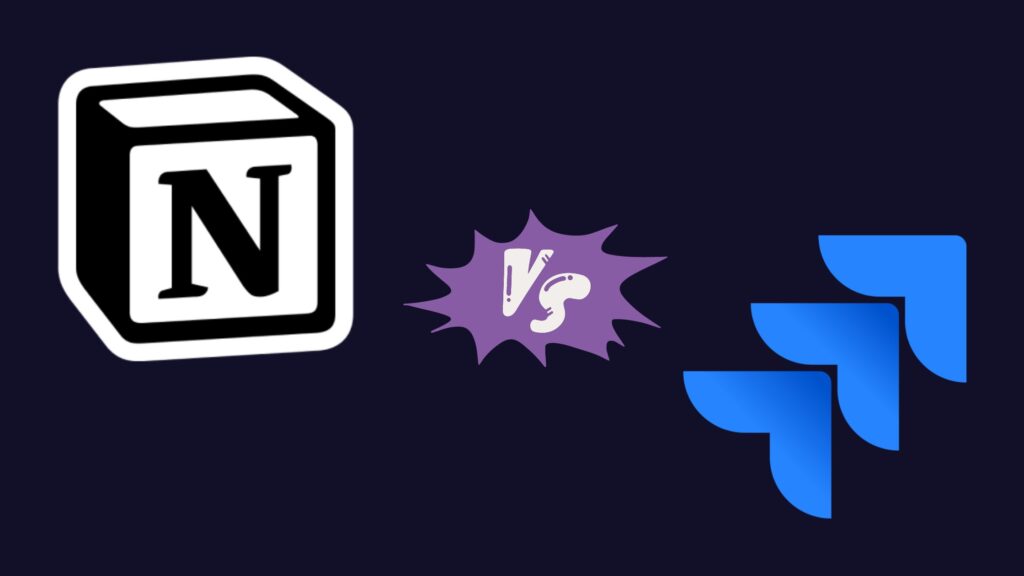
Notion vs Jira: So Which is Better?
When it comes to choosing between Notion and Jira, the answer really depends on your team’s specific needs and the nature of your projects.
Notion is ideal for teams that need flexibility and a broad range of tools in one place. It’s perfect for those who value a streamlined approach to note-taking, document storage, and project management, all within a highly customizable environment. If your team thrives on versatility and the ability to adapt the tool to your workflow, Notion could be the right choice.
Jira, on the other hand, is a powerhouse for software development and technical project management. It’s designed for teams that require robust features like Scrum boards, roadmaps, and deep integration with other development tools. If your focus is on complex project management, particularly in a technical setting, Jira’s extensive functionality might be what you need.
However, if you’re looking for a solution that combines the best of both worlds—without the need for multiple tools—Teamplate could be the better option. Teamplate offers the flexibility and collaborative features of Notion, along with the project management capabilities of Jira, all within a single, intuitive platform.
Why Teamplate Might Be the Best Choice
- All-in-One Solution: Unlike Notion and Jira, which require integrations to achieve full functionality, Teamplate brings everything together in one platform. This means less context switching and a more cohesive workflow.
- Simplified Collaboration: With features like chat, video calls, screen recording, and Kanban boards, Teamplate offers a seamless communication and project management experience that keeps your team connected and focused.
- Cost-Effective: Teamplate’s freemium model provides all the essential features without the need for multiple subscriptions, making it a more affordable option for small-to-medium teams.
In the end, the best choice comes down to what your team values most. If you need a robust, specialized tool, Jira is excellent. If you prefer flexibility and customization, Notion is strong. But if you’re looking for an all-encompassing platform that reduces complexity and enhances productivity, Teamplate might just be the ideal solution for your team.
In today’s fast-paced work environment, effective project management is crucial for teams to stay organized, meet deadlines, and achieve their goals. With a wide range of project management tools available, finding the right one for your team can be challenging. Among the popular choices, Asana stands out as a powerful tool known for its ease of use and robust features, making it a go-to solution for many teams around the world.
One of the best ways to determine if Asana is the right fit for your needs is by taking advantage of their free trial. This allows you to:
- Explore its features
- Test its capabilities
- See how it integrates into your workflow—all without any financial commitment
However, while Asana is an excellent tool, it’s important to consider all your options before making a decision. There may be other tools that better align with your team’s unique needs and working style. In this article, we’ll not only delve into the benefits of Asana’s free trial but also introduce you to an alternative that might be the perfect fit for your team: Teamplate.
Table of Contents

What’s Included in the Asana 30-Day Free Trial?
The Asana 30-day free trial is an excellent opportunity for users to explore the full spectrum of Asana’s features without any financial commitment. During this trial period, you gain unrestricted access to all the platform’s functionalities, allowing you to thoroughly evaluate how Asana can enhance your team’s productivity and project management.
Basic Features
Task and Project Management:
- Create, organize, and manage tasks efficiently
- Assign tasks to team members
- Set deadlines and track progress
- Keep everyone on track and prevent tasks from falling through the cracks
Collaboration Tools:
- Communicate easily with your team
- Share files and provide feedback directly within the platform
- Centralize all communication, making it easier to keep everyone on the same page
Project Tracking:
- Monitor task completion
- Identify potential bottlenecks
- Adjust workflows in real-time to keep projects on course
Integrations:
- Seamlessly integrate with popular tools like Google Drive, Dropbox, and Slack
- Incorporate Asana into your existing workflow for a streamlined process
Mobile App:
- Manage tasks on the go with Asana’s mobile app
- Stay connected and handle projects from your smartphone or tablet
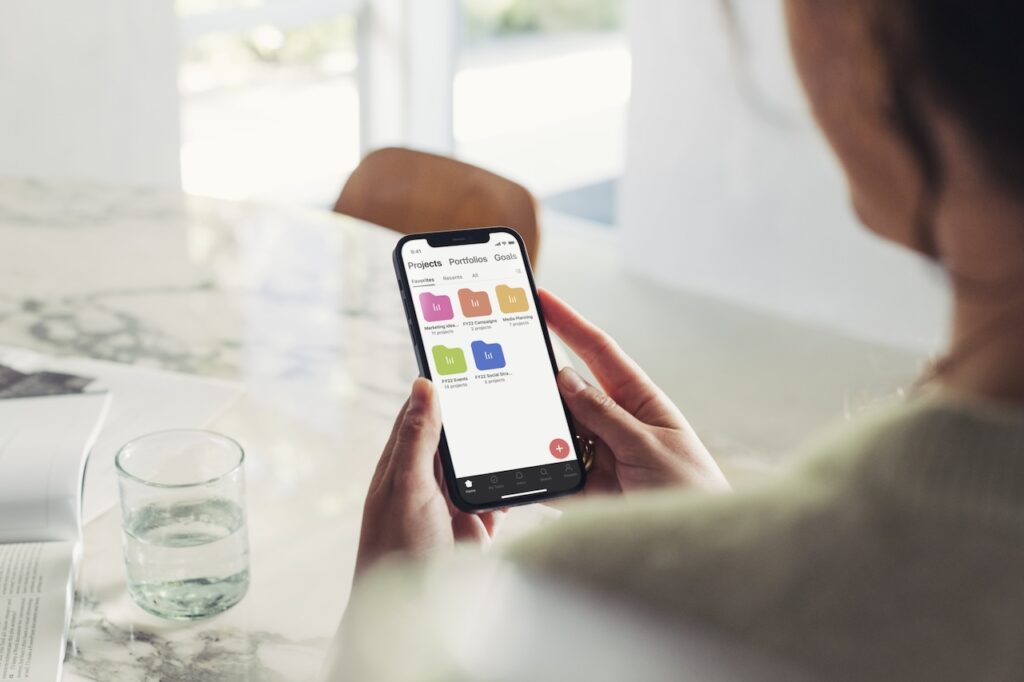
Advanced Features
Workflow Builder:
- Automate and customize your project workflows for efficiency
Unlimited Dashboards:
- Visualize key project metrics and track performance in real-time
Advanced Search:
- Easily find specific tasks or projects with Asana’s advanced search functionality
Custom Fields:
- Add specific data points to tasks and projects
- Tailor the platform to meet your unique workflow requirements
Unlimited Free Guests:
- Collaborate with external stakeholders by inviting unlimited free guests
Task Templates:
- Create standardized task structures that can be reused across different projects
Admin Console:
- Manage team members, set permissions, and monitor platform usage with advanced administrative controls
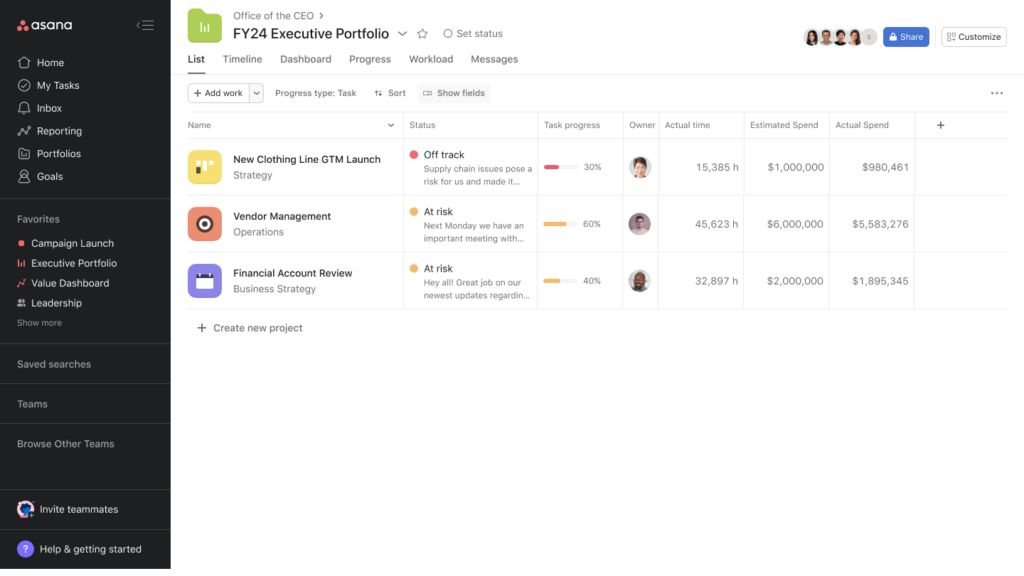
What Happens After the 30-Day Trial in Asana?
When your 30-day free trial comes to an end, you’ll need to decide whether to continue with a paid plan or downgrade to Asana’s basic plan, which is free of charge. Here’s what you can expect:
Paid Plans
If you choose to continue using Asana’s advanced features, you’ll need to select one of the paid plans that best suits your team’s needs. Asana offers several pricing tiers, each designed to cater to different team sizes and requirements:
- Basic Plan:
- Free for teams of up to 15 members
- Includes essential task and project management features
- Ideal for smaller teams or those just getting started with project management
- Premium Plan:
- Offers advanced features such as custom fields, advanced search, and timeline view
- Best for teams that need more sophisticated tools to manage projects efficiently
- Business Plan:
- Designed for larger teams
- Includes features like portfolios, workload management, and custom rules
- Suitable for organizations with complex project management needs
- Enterprise Plan:
- For large organizations requiring advanced security, compliance, and customization options
- Offers the highest level of control and flexibility
Free Basic Plan
If you don’t wish to continue with a paid plan, you can simply remain on the basic plan. While this option is limited compared to the paid plans, it still provides access to Asana’s core task and project management features, making it a viable option for smaller teams or individual users.
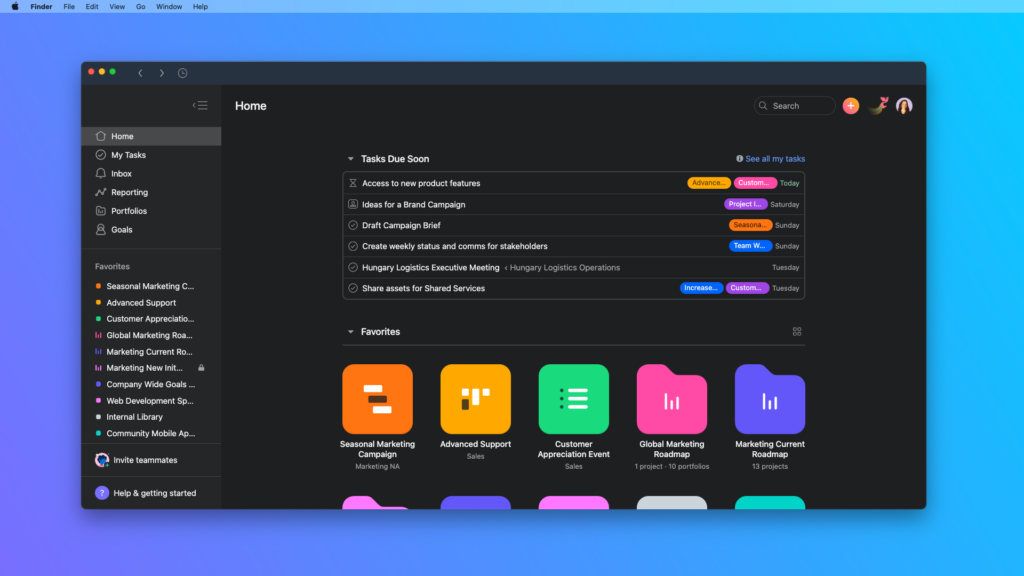
Can You Cancel the Asana 30-Day Free Trial and Not Pay?
Yes, you have the flexibility to cancel your Asana 30-day free trial at any time before the trial period ends, ensuring that you won’t be charged. Additionally, if you prefer to remain on the basic plan, you won’t incur any charges after the trial ends.
To cancel your free trial:
- Navigate to your account settings
- Click on the billing tab
- Select “Cancel Trial”
This process is straightforward and ensures that you maintain control over your subscription, only upgrading if and when you’re ready.
Limitations of Asana (and Why Alternatives Matter)
While Asana is a powerful tool, it’s not without its limitations, which may lead some teams to explore alternatives.
Learning Curve
Asana’s extensive features come with a potential downside: a steep learning curve. New users may find onboarding and setup challenging, particularly if they are unfamiliar with project management tools. This can slow down adoption and delay productivity gains.
Customization Limitations
Although Asana offers a range of features, its customization options are somewhat limited. Teams with unique workflows may struggle to tailor the tool to fit their specific needs. This lack of flexibility can hinder the effectiveness of the platform for certain projects.
Pricing Post-Trial
After the 30-day free trial, Asana’s advanced features come with a cost. Depending on the plan, these costs can add up, particularly for larger teams. For those on a tight budget, the high pricing can be a significant drawback, making it essential to consider more affordable alternatives.
These limitations highlight why it’s important to explore other tools that might better align with your team’s requirements, such as Teamplate, which offers a more flexible and cost-effective solution.

Introducing Teamplate: The Superior All-in-One Collaboration Tool for Your Team
In the dynamic world of project management and team collaboration, finding a tool that effortlessly integrates all the features you need can be a challenge. Enter Teamplate—a user-friendly, all-in-one collaboration platform crafted specifically for smaller-scale companies that outshines industry giants like Asana, Slack, Zoom, Jira, and Confluence.
By combining the best elements of these tools into a single, cohesive platform, Teamplate eliminates the need for constant context switching, allowing your team to focus on what truly matters: achieving your goals efficiently.
Why Choose Teamplate Over Asana?
Teamplate isn’t just another collaboration tool; it’s a powerful solution designed to:
- Enhance productivity
- Save time and money
- Empower your team to work more effectively together—all in ways that Asana simply can’t match
Boost Productivity
Unified Platform:
Unlike Asana, which may require multiple integrations to meet all your needs, Teamplate offers a single platform that handles communication, project management, and more, reducing the need to juggle multiple apps.
Streamlined Workflow:
With integrated features like chat, video calls, and Kanban boards, Teamplate ensures that you spend more time focusing on what’s important—getting things done—without the need for additional tools or subscriptions.
Save Time & Money
Cost-Effective Solution:
While Asana’s advanced features come at a premium, Teamplate consolidates your tools into one affordable subscription. This eliminates the need for multiple costly services and ensures you get the most out of your investment.
Efficiency Across Platforms:
Minimize the time wasted searching for information across different apps. With Teamplate, everything you need is in one place, making it easier to manage your projects and communicate with your team.
Empower Your Team
Seamless Collaboration:
Teamplate brings all team interactions under one roof, fostering a connected and collaborative environment, whether your team is working remotely or in the office—an edge that Asana’s separate communication tools can’t compete with.
Accessible for All:
With a freemium model that offers all the essential features, Teamplate ensures that even small teams can access powerful collaboration tools without breaking the bank. This is particularly advantageous compared to Asana’s potentially high post-trial costs.

Key Features of Teamplate
Teamplate offers a comprehensive set of features that not only match but often exceed what Asana provides, making it the superior choice for teams seeking an all-in-one solution:
Chat
Effortless Collaboration:
- Communicate with your team and clients across different projects and spaces
- Enjoy real-time communication with instant messaging, file sharing, and threaded conversations
Video Calls
Integrated Communication:
- Built-in video call functionality for efficient meetings and remote collaboration
- Screen recording included to ensure no important discussion is lost
Screen Recording
Simple Sharing:
- Easily record your screen and upload recordings directly into chats, tickets, or the data room
- Simplify information sharing and ensure everyone is informed

Kanban Boards
Customizable Workflow:
- Organize your tasks, manage projects, and visualize progress with customizable Kanban boards, epics, and sprints
- Switch between backlog, Kanban, and board views to match your preferred way of working
Calendar
Integrated Scheduling:
- Stay on top of your schedule and manage meetings effortlessly with Teamplate’s integrated calendar
- Keep everything in sync without needing a separate tool
Data Room
Secure File Management:
- Securely store, upload, and share files in various formats, including Excel, Word, PDF, and images
- Set permissions on a per-file basis to ensure sensitive information is only accessible to the right people
Wiki & Notes
Knowledge Sharing:
- Capture and share ideas, meeting notes, and important information with your team using the Wiki feature
- Use the Notes feature as your personal notepad, visible only to you—something Asana lacks
Dashboard
Centralized Management:
- Manage your events, tasks, and data from a centralized dashboard
- Get a clear overview of everything happening within your projects, streamlining your workflow far beyond what Asana’s dashboard offers

The Teamplate Advantage Over Asana
All-in-One Platform
Eliminate the need for multiple tools and integrations by consolidating everything into Teamplate, simplifying your workflow and reducing complexity in ways that Asana’s segmented approach can’t achieve.
Simple & Intuitive
Designed to be easy to use and adopt, Teamplate minimizes the need for extensive training and onboarding, allowing your team to start collaborating right away. This user-friendly experience is often more intuitive than Asana’s setup, especially for new users.
Affordable & Accessible
With a freemium model that offers all features, Teamplate ensures that even small teams can access powerful collaboration tools without the high costs associated with Asana’s premium plans.
Whether you’re managing a small team or overseeing multiple projects, Teamplate provides the tools you need to work smarter, not harder. With its comprehensive feature set, affordability, and focus on simplicity, Teamplate is the ideal solution for teams looking to boost productivity, save time and money, and foster a collaborative work environment—far surpassing what Asana can offer.
Remote work is on the rise! However, the freedom it offers brings the challenge of maintaining team connection and productivity. That’s where the best collaboration tools for remote teams come into play. Think of these tools as your digital partners, bridging the physical gap, ensuring seamless communication, and efficient project management. From task management to idea brainstorming and staying connected, the right collaboration tools for remote teams can make your remote team feel as cohesive as an in-office team. This guide will help you navigate the top collaboration tools for remote teams. We’ll delve into the features, benefits, and pricing of each tool, helping you select the best fit for your team’s needs.
Table of Contents
Finding the Right Fit: Choosing Collaboration Tools for Remote Teams
Choosing the best collaboration tool for your remote team can be overwhelming with so many options available. But don’t worry, we’ve got you covered!
Identify Your Team’s Needs
Before diving in, take a moment to evaluate your team’s specific requirements:
- Team Size: How large is your team?
- Project Nature: What types of projects do you handle?
- Preferred Communication: How does your team prefer to communicate and collaborate?
Essential Features to Consider
Communication:
- Instant Messaging: Keep everyone connected with real-time chat.
- Video Meetings: Conduct virtual meetings, presentations, and team-building exercises.
- File Sharing: Collaborate on documents, presentations, and other files seamlessly.
Project Management:
- Task Management: Assign tasks, set deadlines, and track progress visually.
- Automation and Workflows: Streamline repetitive tasks to boost efficiency.
- Project Dashboards: Get real-time insights into project progress and performance.
Collaboration Tools:
- Shared Documents and Annotations: Work together on documents and provide instant feedback.
- Visual Brainstorming Tools: Capture ideas and collaborate using digital whiteboards.
- Discussion Forums: Share knowledge, ask questions, and foster team discussions.
Additional Factors:
- Tool Integrations: Ensure the tool integrates with your existing software, like calendars and email.
- Security and Privacy: Choose a tool that prioritizes data protection and privacy.
- User-Friendliness: Make sure the tool is easy to use for all team members, regardless of their technical skills.
- Scalability: Select a tool that can grow with your team.
Remember, the ideal collaboration tool is the one that aligns best with your team’s unique needs. Take your time, conduct thorough research, and get ready to enhance your team’s productivity and collaboration!
Best Collaboration Tools for Remote Teams in 2024

Trello: Your Visual Collaboration Playground
Trello transforms ideas into reality with its visual approach to project management. Imagine a digital board filled with sticky notes, but with powerful features and enhanced functionality. Trello is simple, intuitive, and infinitely customizable, making it ideal for teams of all sizes who need to organize their work, track progress, and collaborate effortlessly.
Features:
- Boards, Lists, and Cards: Organize your projects with boards, structure workflows with lists, and manage tasks with cards.
- Drag-and-Drop Functionality: Easily move cards to reflect progress and priorities.
- Labels and Checklists: Use labels for categorization and checklists for detailed task tracking.
- Comments and Attachments: Share ideas, ask questions, and attach files directly to cards for streamlined collaboration.
- Tool Integrations: Connect Trello with your favorite apps like Slack, Google Drive, and Dropbox for a seamless workflow.
Benefits:
- Enhanced Team Communication: Keep everyone in the loop with real-time updates and shared information.
- Transparency and Accountability: Visualize project progress and individual responsibilities to ensure everyone is aligned and accountable.
- Increased Productivity: Optimize workflows, eliminate bottlenecks, and accelerate task completion.
- Boosted Morale and Engagement: Make work engaging and interactive with Trello’s visual and user-friendly interface.
- User-Friendly: Trello is easy to learn and use, even for non-technical team members.
Pricing:
- Free Plan: Trello’s free plan offers unlimited cards, lists, and members, perfect for small teams or individuals starting out.
- Standard Plan: At $5 per user per month, this plan includes all free plan features plus unlimited boards and advanced checklists.
- Premium Plan: For $10 per user per month, get all Standard plan features along with unlimited guests and multiple view options.
- Enterprise Plan: Designed for large teams, this plan includes all Premium features plus advanced board management and power-ups.

Asana: Your Ultimate Project Management Command Center
Asana is a robust solution for managing projects, assigning tasks, and keeping your team on track. Think of it as a command center where you can visualize progress, streamline workflows, and meet deadlines with confidence. Asana offers the structure and flexibility needed to stay organized and achieve your goals.
Features:
- Break Down Projects into Manageable Tasks: Create tasks with clear descriptions, due dates, and assignees to simplify large projects.
- Assign Tasks and Track Progress: Monitor who is working on what and see real-time progress to keep everyone informed and aligned.
- Visualize Timelines and Dependencies: Use Gantt charts to view project timelines and identify task dependencies, ensuring no steps are missed.
- Collaborate with Comments and Attachments: Discuss tasks, share ideas, and attach files directly to tasks for smooth collaboration.
- Automate Repetitive Tasks: Implement “Rules” to automate repetitive tasks like assigning due dates or adding tasks to specific projects, freeing up time for more important work.
- Tool Integrations: Connect Asana with apps like Slack, Google Drive, and Dropbox for a cohesive workflow.
Benefits:
- Increased Productivity and Efficiency: Achieve faster results with clear task management and automated workflows.
- Improved Communication and Collaboration: Enhance team communication and keep everyone updated with real-time information.
- Enhanced Project Planning and Execution: Break projects into manageable steps, track progress visually, and ensure timely completion.
- Scalability for Growing Teams: Asana adapts to your team’s evolving needs with flexible plans and features.
Pricing:
- Personal Plan: The free Personal plan includes unlimited tasks, projects, and collaborators, ideal for individuals and small teams starting with task management.
- Premium Plan: At $10.99 per user per month, this plan includes custom fields, advanced search and filtering, timeline view, and more.
- Business Plan: For $24.99 per user per month, the Business plan offers advanced workload management, portfolios with custom dashboards, and custom rules and automation.
- Enterprise Plan: Designed for large organizations, this plan includes all Business features plus a dedicated customer success manager, single sign-on, enhanced security, and more.
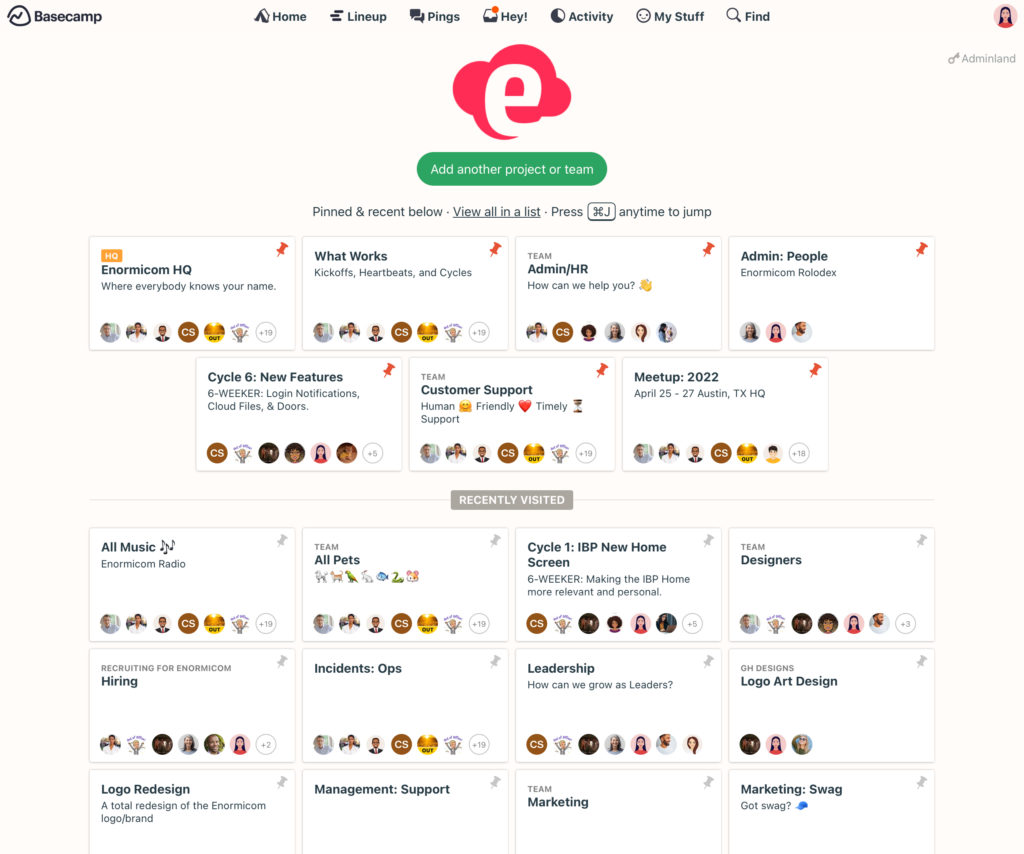
Basecamp: More Than Just Project Management
Basecamp is more than a tool; it’s a philosophy that emphasizes clear communication, focused collaboration, and a distraction-free environment to help your team thrive.
Features:
- Asynchronous Message Boards: Discuss projects, share ideas, and collaborate without the pressure of real-time interaction.
- To-Do Lists and Task Management: Track tasks, set deadlines, and prioritize work to ensure individual and team success.
- File Sharing and Document Collaboration: Share documents, work together on projects, and access information anytime, anywhere.
- Group Chat and Video Conferencing: Connect for real-time discussions when necessary.
- Popular Tool Integrations: Integrate with your favorite apps for a seamless workflow.
Benefits:
- Improved Focus: Minimize distractions to enhance focus and productivity.
- Clear Communication and Transparency: Foster open communication and keep everyone informed and aligned.
- Enhanced Accountability: Encourage teamwork by assigning responsibilities and tracking progress.
- Simplified Project Management: Keep everything organized in one place for better project oversight.
- Increased Flexibility and Work-Life Balance: Promote asynchronous communication and flexible schedules for a better work-life balance.
Pricing:
- Basecamp Personal: A free plan with limited features, ideal for individuals and freelancers.
- Basecamp Standard: $15 per user per month, includes 500GB of storage.
- Basecamp Business: $299 per month, a flat-rate plan for unlimited users and projects, with 5TB of storage.

ClickUp: Your Comprehensive Project Management and Collaboration Hub
ClickUp is your one-stop shop for all things project management and collaboration, designed to empower your team and streamline your workflow.
Features:
- Visualize Goals and Projects: Set clear objectives, define milestones, and track progress visually.
- Brainstorm and Plan with Mind Maps: Generate ideas, plan projects, and connect thoughts using visual mind maps.
- Customizable Boards, Lists, and Cards: Organize tasks, visualize workflows, and tailor the layout to fit your specific needs.
- Built-In Automation for Tasks: Automate tasks, set triggers and actions, and focus on strategic work.
- Integrate with Your Favorite Tools: Connect ClickUp to your preferred apps for a seamless and integrated experience.
Benefits:
- Improved Visibility and Control: Get a comprehensive view of your projects, identify bottlenecks, and make informed decisions.
- Top-Notch Communication and Collaboration: Ensure everyone is on the same page and work together efficiently with open communication.
- Increased Productivity and Efficiency: Streamline workflows, automate repetitive tasks, and achieve more in less time.
- Extremely Flexible and Scalable: Adapt ClickUp to your growing needs, whether you’re a small team or a large organization.
Pricing:
- Free Forever: Ideal for individuals and personal use.
- Unlimited: $7 per user per month, perfect for small teams and startups.
- Business: $12 per user per month, suited for growing teams and organizations.
- Enterprise: Custom pricing for advanced features and dedicated support.

Teamplate: Your Ultimate All-in-One Collaboration Tool
In the world of remote work and digital collaboration, Teamplate stands out as a user-friendly, comprehensive tool designed specifically for smaller scale companies. By integrating the best features of popular tools like Slack, Zoom, Jira, and Confluence, Teamplate eliminates the need for context switching, allowing users to focus on getting things done efficiently.
Key Benefits for Your Team:
Boost Productivity
- Focus on What Matters: With Teamplate, there’s no need to constantly switch between different apps. All your communication and project management tools are in one place.
- Streamlined Communication: Features like chat, video calls, and Kanban boards ensure that you can collaborate seamlessly without losing track of important conversations or tasks.
Save Time & Money
- Reduce Wasted Time: By consolidating multiple tools into one, Teamplate helps you find information quickly and reduces the time lost to context switching.
- Cost-Effective: Instead of paying for multiple subscriptions, you can access all the necessary features within Teamplate, leading to significant cost savings.
Empower Teams
- Unified Platform: With all your interactions happening in one place, Teamplate fosters a seamless collaboration environment, empowering your team to work more effectively.
Comprehensive Features:

Communication
- Chat: Collaborate effortlessly with teams and clients across various projects, spaces, and direct messages. Real-time collaboration is enhanced with instant messaging, file sharing, and threaded conversations.
- Video Calls: Efficiently connect your team and clients for meetings and collaboration. Inbuilt screen recording and video call functionality unify remote teams and facilitate asynchronous communication.
- Screen Record: Easily record your screen and upload the recordings to chats, tickets, and the data room, ensuring everyone stays on the same page.

Project Management
- Kanban Boards: Organize workflows, manage tasks, and visualize progress with customizable boards, epics, and sprints. Switch between backlog, Kanban, and board views to suit your needs.
- Calendar: Manage your schedule and meetings effortlessly, keeping everyone aligned and on time.
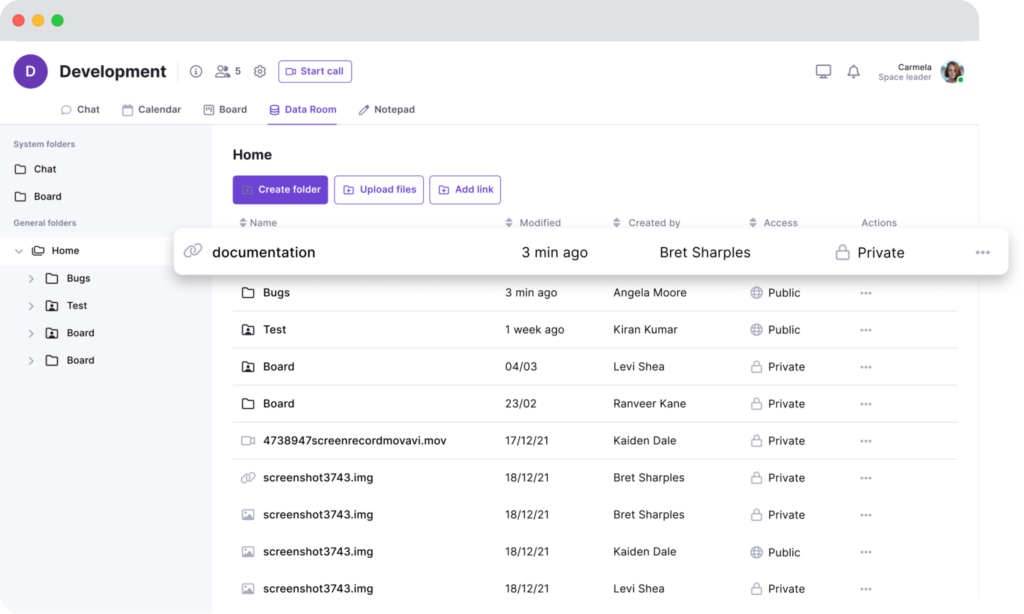
Data Management
- Data Room: Securely store, upload, and share files in various formats, including Excel, Word, PDF, and images. Set permissions per file to ensure data security.
- Wiki & Notes: Document ideas and meeting notes in the Wiki, and use Notes for personal notetaking across all spaces, only visible to you.
Dashboard
- Centralized Management: Oversee your events, tasks, data, and more from a dedicated dashboard, simplifying project oversight and management.

Why Choose Teamplate?
- All-in-One Platform: Say goodbye to juggling multiple tools and integrations. Teamplate brings everything you need into one intuitive platform.
- Simple & Intuitive: Designed for ease of use, Teamplate minimizes the need for extensive training and onboarding, allowing your team to hit the ground running.
- Affordable & Accessible: With a freemium model that includes all features, Teamplate offers an affordable solution for teams of all sizes.
Ready to transform the way your team collaborates? Sign up for Teamplate today and experience the ultimate in productivity and efficiency!
Recap: Collaboration Tools: Your Guide to Teamwork Success!
Navigating the myriad of collaboration tools for remote teams can be overwhelming, but we’re here to simplify the process. Here’s a recap of the tools we discussed to help you pinpoint the perfect solution for your team.
Tools Covered:
- Trello: The Visual Playground
- Asana: Your Project Management Command Center
- Basecamp: More Than Just Project Management
- ClickUp: Your Comprehensive Collaboration Hub
- Teamplate: The Ultimate All-in-One Tool
Collaboration Tools for Remote Teams: A Final Note
Selecting the right collaboration tool can transform your team from disorganized and unproductive to highly efficient and cohesive. With so many options available, you can find the perfect solution for any team size, budget, and specific requirements.
By understanding the features and advantages of each tool and matching them with your team’s unique needs, you can harness the true potential of collaboration and achieve outstanding results.
Effective communication, streamlined workflows, and a unified focus on common goals are essential for successful teamwork.Embark on your project journeys with confidence! Let these collaboration tools for remote teams enable your team to reach new levels of productivity and efficiency.
When managing a project that is too complex for a simple to-do list app but not intricate enough to necessitate a full-scale project management tool, a Kanban app is the ideal solution. Kanban apps have proven their versatility across various project types. Whether it’s managing a content calendar as a blog manager, overseeing a marketing team, or juggling freelance projects and clients, Kanban boards provide an effective way to stay organized. They are even useful for personal projects, like organizing a bachelorette party. The flexibility of Kanban makes it applicable to virtually any project.
While Trello is widely recognized as the gold standard of Kanban apps, many other excellent Kanban tools are available, each with unique strengths that may better suit specific workflows. After extensive testing of numerous Kanban software options, we have identified the eight best Kanban apps that stand out for their functionality and usability. Based on this thorough evaluation, here are the best Kanban apps that can enhance your project management experience.
Table of Contents
The 5 Best Kanban Apps
- KanbanFlow – For simplicity
- Kanban Tool – For built-in time-tracking and managing client projects
- Workstreams.ai – For Kanban within Slack
- Kanbanchi – For Kanban within Google Workspace
- Teamplate – All-in-one Kanban tool

What is Kanban Board Software?
If you’re new to Kanban, it’s helpful to first familiarize yourself with the Kanban method and how it differs from Scrum and Agile methodologies. For a comprehensive understanding, you can refer to these articles on the Kanban method and the distinctions between Kanban, Scrum, and Agile. However, if you just need a quick refresher, here’s a brief overview.
Kanban Boards
Think of Kanban boards as digital workspaces. They provide a visual overview of your entire project, whether you’re building a car (Kanban was originally developed by Toyota in the 1940s!), managing a content calendar, or organizing a bachelorette party.
Kanban Lists
These represent workflows within your Kanban board. At their simplest, Kanban lists might be labeled “To Do,” “Doing,” and “Done.” However, they are most effective when they mirror the actual stages of your production process. For instance, an editorial calendar Kanban board might have lists such as “With Editor,” “Scheduled,” and “Published.”
Kanban Cards
These are the tasks within your Kanban lists. In Kanban apps, cards are moved from one list to another—typically from left to right—along the production line until they are completed.
Kanban board software, with its boards, lists, and cards, offers a flexible and visual way to manage projects of all sizes and complexities, making it a popular choice for teams and individuals alike.
What Makes the Best Kanban App?
First, it’s important to distinguish between dedicated Kanban tools and general project management apps that offer Kanban as part of their feature set. If you’re already using a project management tool you like and it includes Kanban, switching to a dedicated Kanban tool might not be necessary. General project management apps tend to be too complex if you’re only looking for Kanban functionality. Through extensive research and testing, it became clear that specialized Kanban tools are best for those focused solely on Kanban.
All the apps included in this guide are purpose-built Kanban tools. For those seeking a wider array of features, check out our lists of the best free project management apps or the best Trello alternatives.
When evaluating Kanban apps, the following criteria were considered:
Affordability
The focus is on apps that are accessible to almost everyone. They either offer robust free plans or have affordable paid plans on a per-user-per-month basis.
Customization
Every team operates differently, and projects vary widely. Therefore, the apps included are highly customizable to meet diverse user needs.
Integrations
A Kanban app is only truly effective if it integrates seamlessly with the other tools you use. Integration capabilities were a key consideration.
Ease of Use
Many sophisticated Kanban apps cater heavily to software engineering and product development teams, which can make their user interfaces intimidating for others. This guide emphasizes “lightweight” Kanban apps that are user-friendly across various industries and team structures.
AI Automation
While AI in Kanban tools is still in its early stages, some apps are beginning to use machine learning to optimize Kanban workflows. This emerging feature was also considered in the evaluations.
By focusing on these criteria, the guide aims to help you find the best Kanban app that fits your specific needs and enhances your project management efficiency.
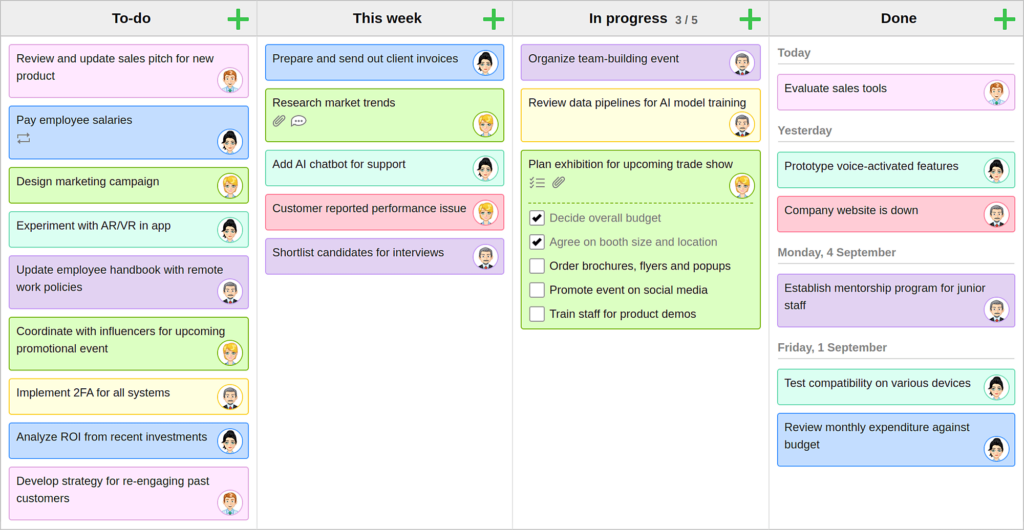
KanbanFlow: The Essential Kanban Tool
KanbanFlow stands out as the most stripped-down Kanban tool tested, but sometimes simplicity is exactly what you need. If minimal distractions are your goal, KanbanFlow is ideal.
Despite its basic nature, KanbanFlow covers all the essential features of a Kanban app and performs them well. Users can add lists and cards as usual, and customize their cards with color-coding for different task types. Additionally, swimlanes can be used to divide the board into sections, which is useful for showing multiple people’s work on one board or setting aside tasks for later.
A particularly useful feature discovered during testing is the ability to view and check off subtasks directly from the board without opening a card. When a subtask is checked off, it grays out rather than disappearing, which helps visualize overall progress towards larger tasks. Additionally, KanbanFlow allows for mass updates to cards, such as adding a new checklist of subtasks to every card in a list, which is helpful for teams working in sprints and needing to update their strategy across the board.
The card design in KanbanFlow is straightforward yet comprehensive. It allows for listing subtasks, including Markdown-formatted descriptions, adding labels, and setting time estimates for tasks. You can even create recurring cards for tasks that need to be done regularly, like in a standard to-do list app.
KanbanFlow also offers reporting on the time spent on tasks by the user and team, along with filters to sort tasks and view specific details on the boards. It’s a powerful tool for getting work done and keeping things organized without unnecessary distractions.
One of KanbanFlow’s standout features is its built-in Pomodoro timer. By clicking the timer button in the bottom toolbar, selecting a card, and starting the timer, users get 25 minutes to work on a task before being reminded to take a break. This feature supports productivity by structuring work into focused intervals.
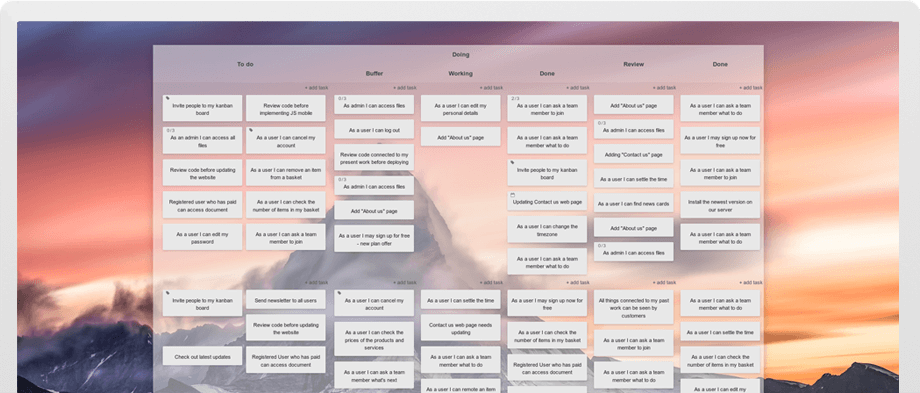
Kanban Tool: A Simple Yet Powerful Kanban App
Kanban Tool is another streamlined Kanban app featuring a clean interface with minimal distractions. While the UI hasn’t seen updates since at least 2017, its functionality remains strong. The vibrant color-coding pops off the screen, allowing users to instantly recognize task types, making standard color-labeling feel a bit insufficient in comparison.
One of the standout features of Kanban Tool is its Analytics. With a simple click from your board, you can access a breakdown of your cards by type and generate time reports to see how much work was logged each day on each card. The cumulative flow feature shows your work’s progression towards completion, and a detailed changelog records all team activities on the project. This is particularly useful for agencies or freelancers managing multiple projects for different clients simultaneously.
Despite its simple appearance, Kanban Tool boasts a host of powerful features. You can add custom fields to cards, name each card color from its settings, and enable Power-Ups for additional functionality like a calendar view, checklist templates, and emoji. All changes are logged back to the detailed analytics, providing comprehensive tracking.
Kanban Tool offers a variety of templates to help you get started, with standard columns for planning projects by time, process, and more. The board is highly customizable, allowing you to add any sections and swimlanes necessary for your workflow. Within cards, users can select a customizable color tag, add details, and quickly create and add new task cards. When working on a task, simply drag it to the sidebar on the right, and Kanban Tool will start timing your work. You can switch focus to a new task by dragging it into the sidebar.
Kanban Tool is also one of the first Kanban apps to integrate an AI assistant. The software collaborates with Open AI (the creators of ChatGPT) to enhance the setup process of your Kanban boards. The AI assistant analyzes your needs and suggests layouts and card types, and can even automatically generate project-specific content on your board. This feature significantly reduces the learning curve, allowing users to quickly adopt an effective Kanban workflow from day one.
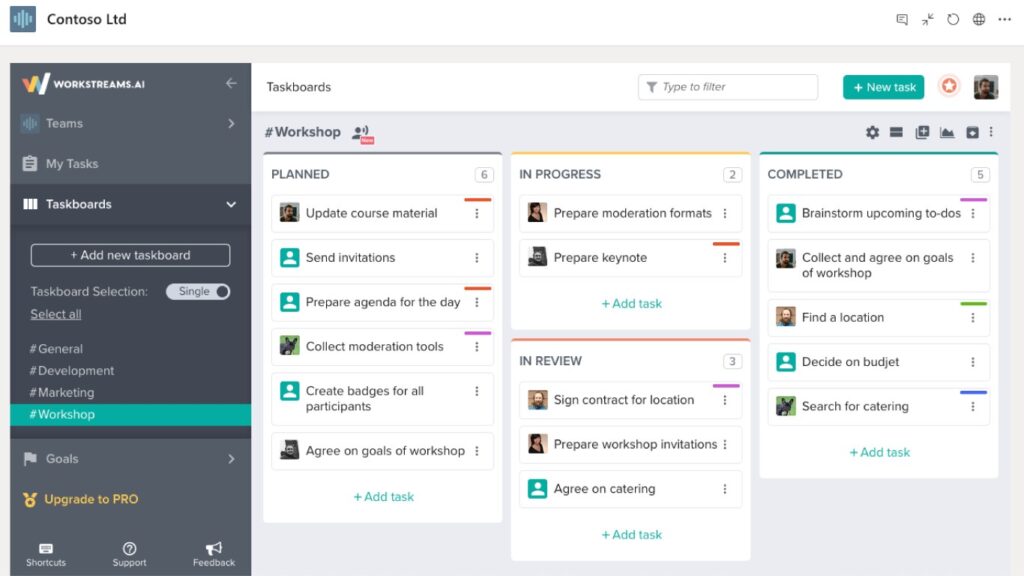
Workstreams.ai: Seamless Integration with Slack and Microsoft Teams
If you already use Slack or Microsoft Teams for team communication, Workstreams.ai is worth checking out. It offers a highly integrated Kanban experience that connects directly with your communication channels. Rather than creating a separate Workstreams.ai login, you can sign up using your Slack or Microsoft account. This tight integration allows you to manage your taskboard almost entirely from within Slack or Microsoft Teams, making project management seamless and efficient.
The taskboards in Workstreams.ai use a bot to align tasks with your Slack or Teams environment. You can create cards, check off actions, and generate reports directly from within these channels. This level of integration means you don’t have to spend much time on the Workstreams.ai interface itself.
One of the standout features of Workstreams.ai is the “Task chat” on every card, which other Kanban tools typically call “comments.” This feature ensures consistent and accessible communication around your workflows. When you tag someone in a Task chat, the notification is instant, arriving directly in Slack. This immediate notification system helps prevent important messages from getting lost, a common issue with email notifications.
The user interface of Workstreams.ai is sleek and familiar, especially for Slack users. The board design resembles Slack’s UI, making it easy to adapt to. Lists are called “Worksteps” and cards are called “Tasks,” containing all the necessary details and fields you would find in other project management apps. You can add custom fields to cards, duplicate cards with a single click, and set up recurring tasks. This comprehensive functionality is all integrated into your team chat app.
Workstreams.ai also offers various customization options. You can add custom fields to cards, duplicate a card with just one click, and set up recurring tasks. The ability to manage these directly within your team chat app enhances efficiency and keeps your workflow streamlined.
Workstreams.ai pricing includes a free plan that offers unlimited tasks and users with all core features. For additional functionalities such as Workstep automation, calendar view, and due dates, the Pro plan is available at $9.99/month/user.
By integrating deeply with Slack and Microsoft Teams, Workstreams.ai provides a robust and user-friendly Kanban experience, ensuring smooth project management without the need to switch between multiple platforms.
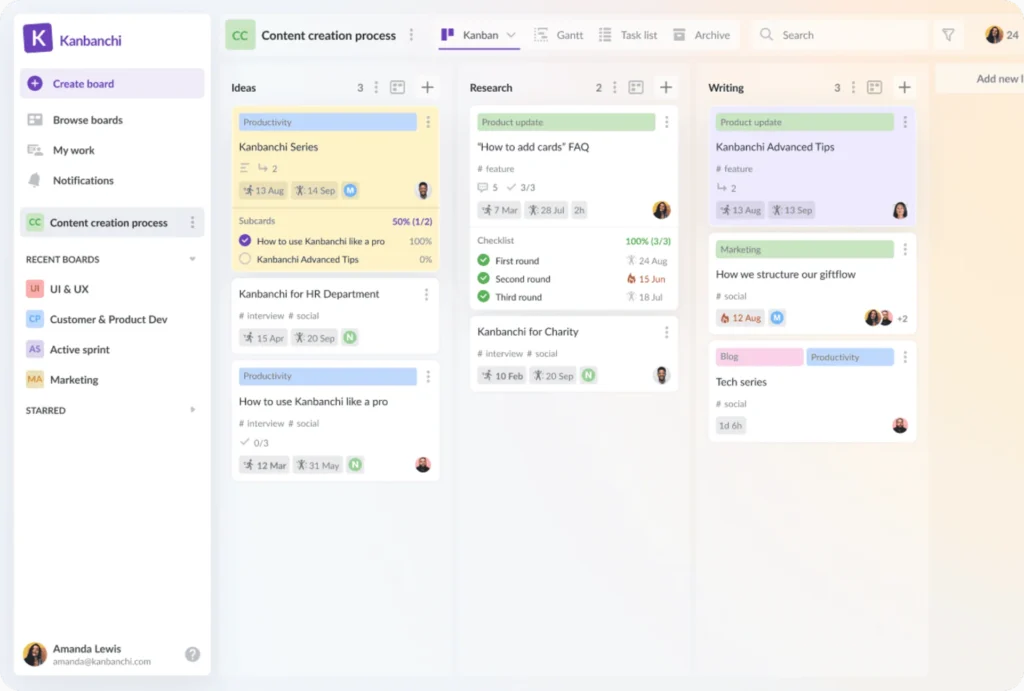
Kanbanchi: Perfect for Google Workspace Users
Kanbanchi isn’t a Google product, but it has been specifically designed to work seamlessly with Google Workspace. This Kanban app integrates tightly with Google Calendar, Google Meet, Google Drive, Gmail, and other Google apps. Despite its Google-centric functionality, the interface design closely resembles that of a Microsoft product, making it look like it could be a feature within Microsoft Teams. However, its features and integrations are clearly aimed at Google loyalists.
For example, you can click an “Add to Google Calendar” button on any card to copy task due dates to your Google Calendar, ensuring you get notifications from there. It’s also easy to attach files to cards straight from Google Drive, and conversely, you can add your Kanban board to your Drive. Additionally, you can create cards for your Kanban board directly through Gmail by emailing a specific address.
One of the features that stood out in Kanbanchi is the built-in time tracker, which begins tracking your time when you click “Start working on it.” You can also add custom properties to all cards on a board in bulk with one action. If you’re already using Trello or Jira for Kanban and considering switching, you can import entire boards directly from these apps or from a CSV, and they’ll appear in full on Kanbanchi.
However, Kanbanchi does not come with a free plan, and its pricing has increased recently. The Premium plan is $16.99/month/user, and if you need time-tracking and reporting, the Professional plan is $41.99/month/user. If you’re a Google Workspace user who spends most of your time in Gmail, it might be worth checking out a Kanban for Gmail app like Sortd if budget is a concern. Alternatively, you can create your own Kanban board in Google Sheets.

Teamplate: The Ultimate Kanban App with All-in-One Collaboration Tools
Teamplate is a user-friendly, all-in-one collaboration tool designed to meet the diverse communication and project management needs of smaller scale companies. Built to rival tools like Slack, Zoom, Jira, and Confluence, Teamplate combines their functionalities into one cohesive platform, eliminating the need for context switching and allowing users to focus on productivity.
Kanban Boards: The Core of Teamplate
Organize Workflows
- Customizable Boards: Tailor your Kanban boards to fit your unique project needs. Whether you’re managing a product launch, a marketing campaign, or daily team tasks, you can set up boards that reflect your specific processes.
- Epics and Sprints: Break down large projects into manageable chunks with epics and sprints. This feature helps in planning and tracking long-term projects by dividing them into smaller, actionable tasks.
- Task Categories: Use color-coded categories to differentiate between various types of tasks. This visual distinction makes it easy to prioritize and manage different work streams.
Views
- Backlog View: Keep a comprehensive list of all tasks that need to be addressed. This view helps in planning and prioritizing future work without cluttering your active board.
- Kanban View: The traditional Kanban view allows you to see tasks in their respective stages of completion. Move tasks from ‘To Do’ to ‘In Progress’ to ‘Done’ with simple drag-and-drop functionality.
- Board View: For a more detailed overview, switch to the board view. This view offers additional insights into task details, deadlines, and assigned team members, helping you stay on top of every aspect of your project.
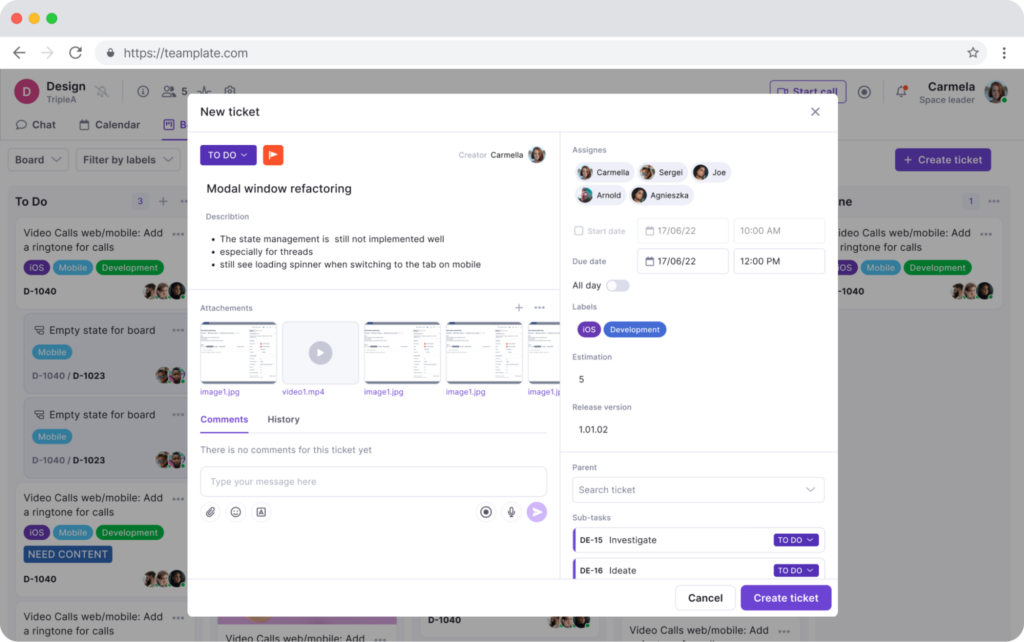
Task Management
- Drag-and-Drop Interface: Easily move tasks through different stages of your workflow with an intuitive drag-and-drop interface. This simple interaction streamlines task updates and ensures everyone is aware of the current status.
- Task Details: Click on any task to view and edit its details. Add descriptions, attach files, set due dates, and assign team members to ensure all relevant information is readily available.
- Subtasks and Checklists: Break down tasks into smaller, manageable subtasks. Use checklists to track progress within a task, ensuring nothing falls through the cracks.
- Labels and Tags: Organize tasks with labels and tags for quick identification and filtering. This feature is especially useful for categorizing tasks by priority, department, or project phase.
- Notifications and Alerts: Stay informed with real-time notifications and alerts. Teamplate keeps you updated on task changes, upcoming deadlines, and team activities, ensuring you never miss an important update.
Collaboration Tools
- Comments and Mentions: Facilitate team collaboration with task-specific comments. Mention team members to draw their attention to specific tasks or updates, promoting clear and efficient communication.
- Attachments: Attach relevant documents, images, and files directly to tasks. This centralized storage ensures all necessary materials are easily accessible and organized.
- Activity Logs: Track the history of each task with activity logs. See who made changes, when they were made, and what was updated, providing transparency and accountability within the team.
By integrating these robust features, Teamplate’s Kanban boards offer a powerful, flexible, and user-friendly way to manage your projects. They ensure that you can visualize progress, manage tasks effectively, and keep your team aligned and productive.

Why Choose Teamplate?
- All-in-One Platform: Eliminate the need for multiple tools and integrations by using Teamplate for all your collaboration and project management needs.
- Simple & Intuitive: The easy-to-use interface minimizes training and onboarding time, allowing teams to start collaborating immediately.
- Affordable & Accessible: Teamplate’s freemium model offers all features, making it an accessible solution for teams of all sizes.
By choosing one of these top Kanban apps, you can significantly enhance your project management efficiency and ensure your team stays organized and productive.
Conclusion
Choosing the right Kanban app can significantly impact your project’s success and your team’s productivity. The five Kanban apps highlighted in this guide each offer unique strengths that cater to different needs and workflows.
- KanbanFlow provides a straightforward, distraction-free interface, perfect for those who value simplicity.
- Kanban Tool offers robust features and detailed analytics, making it ideal for agencies and freelancers managing multiple projects.
- Workstreams.ai excels in seamless integration with Slack and Microsoft Teams, bringing Kanban functionality directly to your communication channels.
- Kanbanchi is a top choice for Google Workspace users, with strong integration capabilities and a familiar interface.
- Teamplate stands out as the ultimate all-in-one collaboration tool, combining the best aspects of Kanban boards with a comprehensive suite of communication and project management features.
Among these, Teamplate emerges as the best Kanban app, thanks to its user-friendly design, extensive customization options, and powerful collaboration tools. Whether you’re managing a product launch, coordinating a marketing campaign, or organizing daily team tasks, Teamplate’s all-in-one platform ensures that you can streamline your workflows, enhance productivity, and keep your team aligned and focused.
By integrating the right Kanban app into your workflow, you can transform your project management experience, making it more efficient, organized, and effective. Explore these options and find the one that best fits your needs to elevate your project management game.

